Text
It's Oregon Archives Month and we're making some beer zines!
Full disclosure: I'd never made a zine when I decided to do an activity where people would make zines.

But I've been hoarding duplicate beer magazines for ages and I like crafts! Bonus: the Library has a team of people who run Crafternoons every couple weeks and they are making it easy for me to be a newbie.
Over the past couple days I've been practicing on a couple projects.

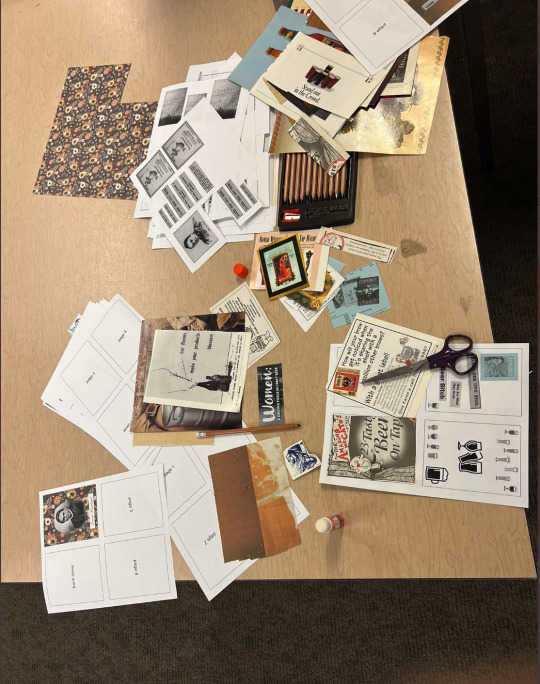
I was at home today (with my shag carpet!) and worked on one about Louisa Weinhard's life (because of course).

And I finished up my original artwork design part!

Now I just need to figure out what to do from here. I think color copy and fold?
Here are scans as it is now -- I did realize I hadn't represented my deep and enduring love of census records in an artistic rendering, so that will need to be corrected ASAP. 😢








3 notes
·
View notes
Text
Collection Report Part 2: Widmer Brothers Brewing Company Records, 1984-2013
Previously, I posted about the collection pick up and the collection description. Today I'm going to tell you about the Widmer Brothers Brewing Company company!
Read Jeff Alworth's book The Widmer Way. It's way better than this post.
Check out the whole guide to the collection.

The Widmer Brothers Brewing Company was founded in 1984 in Portland, Oregon by Kurt and Rob Widmer.
Portland is known as the locus of a local beer scene. The Cartwright Brewing Company founded there in 1980, four years later the Bridgeport Brewing Company and Widmer Brewing followed. Not everyone was keen to try the unfamiliar beers and the brothers struggled to get taverns to offer them. They only sold beer in kegs, believing flavor was degraded by the bottling process, so they were dependent on draft sales. To increase awareness and promote their beers, they formed the "Widmer Designated Drinker" program; the brothers and their friends rented vans (driven by nondrinkers) and traveled to bars where they ordered large amounts of Widmer beer. Fortunately, in future years they sold more than their friends and families consumed.
Kurt was introduced to a wide variety of beer styles while living in Germany in the 1970s, and brewed his own beer after he returned to the United States. He used a traditional strain of yeast obtained from the Brewing Research Institute in Weihenstephan, Bavaria, and later returned to Germany to fine-tune his craft at a brewery in Dusseldorf. The brothers wanted to open a brewery and raised more than $50,000 from family members and an outside investor. With their father Raymond, they set about assembling a small brewery at 1405 NW Lovejoy Street, in an industrial part of NW Portland now known as the Pearl District. At the time, the brewing industry was comprised of large, industrial-sized breweries, which meant this smaller microbrewery had to be creative when acquiring equipment. They purchased used dairy and restaurant equipment (a dairy tank turned mash tun and shrimp cooker turned whirlpool), and by fall began running test batches.
The first Widmer offering, Altbier (German for "old beer"), was offered for sale in early 1985, and the richly flavored brew was soon joined by Weizenbier, a lighter variety filtered wheat beer. They marketed the beer to taverns and pubs, often delivering kegs in the red 1970 Datsun pickup truck they borrowed from their dad. Their first year production totaled 400 barrels. The Dublin Pub was their first longtime account and served both Altbier and Weizenbier; in 1986, owners Carl Simpson and Katie Bullard wanted them to make a third beer. This was a challenge because they only had two fermenters and couldn’t afford to buy another. They decided to leave the Weizenbier unfiltered, use Cascade hops, and put it directly into kegs. The result was a uniquely cloudy beer, the first American-style Hefeweizen or Hefe, which translated from German means "yeast wheat." This style of "American Hefeweizen" and the custom of serving wheat beers with a slice of lemon spread widely. Also in 1986, the brewery released Festbier, a seasonal "winter warmer" beer brewed for winter months.
Annual production increased each year. By 1989, they reached maximum capacity on their brewing equipment and had to turn away new business. They bought two adjoining historic buildings in North Portland that were slated for demolition and planned to renovate them for a new brewery. The 100-year-old Smithson and McKay Buildings had Italianate and Romanesque Revival brickwork, a cast-iron storefront, and were on the National Register of Historic Places. The extensive interior work meant renovation costs were significantly higher than constructing a new facility from scratch. They increased production dramatically, but demand grew even faster. In 1992, they laid out plans for an expansion adjacent to the brewery that would, once again, double production. They continued to only distribute their beer in kegs, but in 1996, decided to begin bottling.
In 1995, they opened a pub and restaurant, the Widmer Gasthaus, and began work on the brewery expansion. In spring of 1996, the new $20 million brewery opened and its brewing vessels and utilities were connected to the older one through under-the-street tunnels. At that time, Widmer produced 11 different beers; this included year-round production of Hefeweizen, Widberry Weizen, Blackbier, Amberbier, Altbier, and Weizen and seasonal beers Doppelbock, Oktoberfest, and Winternacht. In 1997, they introduced new beers, including Widmer Vienna and Czech Pilsner, as well as a hard cider. They made seven year-round brews and the seasonals Golden Bock, Sommerbrau Kolsch, and Hop Jack Pale Ale. In early 2000, they unveiled redesigned packaging, which emphasized the "W" initial in the firm's name and featured more colorful graphics. In 2003, they started brewing Hefeweizen at the New Hampshire RedHook Ale Brewery plant. In 2004, they introduced a seasonal brew called Snowplow Milk Stout, which had been developed by the Oregon Brew Crew, a home brewers club to which the brothers belonged. In 2005, they launched the “W Series,” which showcased their brewmaster’s most innovative and creative recipes.
In 1997, they sold a 27% stake to Anheuser-Busch InBev for $18.25 million in order to gain access to their distribution network and strengthen the company financially at a time when many craft brewers were struggling. Anheuser-Busch InBev had already purchased a stake in Seattle's RedHook Ale Brewery. In 2007, RedHook and Widmer Brothers announced plans to formally merge, forming a new company called the Craft Brewers Alliance, It was renamed Craft Brew Alliance in 2012. By 2013 was composed of five beer and cider brands: Widmer Brothers Brewery, RedHook Ale Brewery (founded in 1981 in Seattle, Washington), Kona Brewing Company (founded in 1994 in Kona, Hawaii), Omission Beer (developed in 2012 in Portland), and Square Mile Cider (launched in 2013).
Kurt Widmer retired in 2016, the Gasthaus closed in 2019, and Anheuser-Busch InBev acquired the company in 2020.
#widmer brothers brewing#jeff alworth#beer history#oregon beer#oregon hops and brewing#widmer archives
2 notes
·
View notes
Text
Collection Report, part 1: Widmer Brothers Brewing Company Records, 1984-2013
In my last post, I posted my pictures from 2020, the pick up day!
Read Part 2: The Company
Today you get a description of the collection -- what you'll see if you come to OSU and want to do research in this collection. Archivists arrange collections into series, which are usually topical but can be by format (e.g., marketing materials, photographs), and you'll see this collection is not exception.

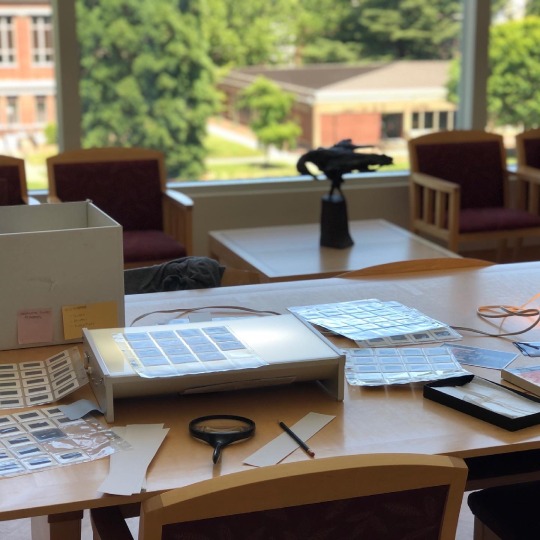



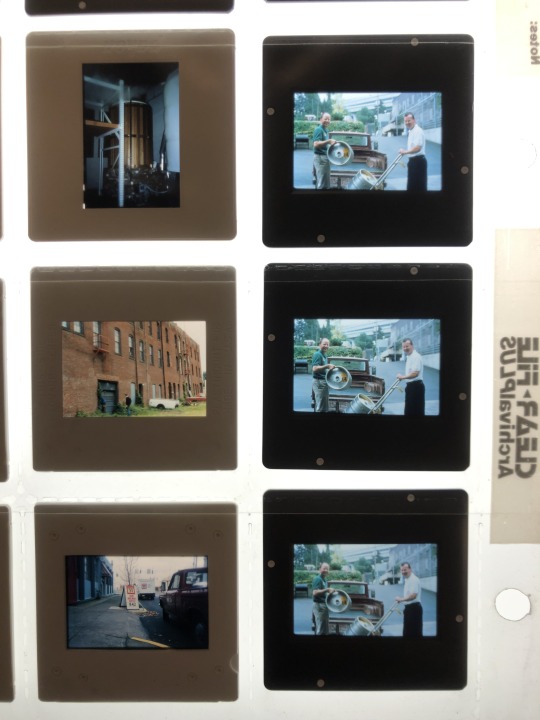
The Widmer Brothers Brewing Company Records includes brewing records, photographs, marketing materials, office files, ephemera, and audio/video content.
Series 1, Brewing Records, documents the early brewing and business operations at the Lovejoy Street facility. Included are the earliest brewing records for Weizenbier, Widmer Bock, Altbier, Festbier, and many other unnamed beers. Also included is an inventory of beer stock, ingredients, and equipment on hand, as well as documentation of expenses for items such as tap handles, beer lines, faucets, and valves. Documents are handwritten and most are on notebook paper.
Series 2, News Clippings, documents the company and their beers, as well as the evolution and changes of the brewing industry and brewers in the Pacific Northwest. The news clippings are arranged chronologically and contain information about the company, the beers, and the brewing industry and brewers in the Pacific Northwest. For several years, the company employed a clipping service, which gathered articles from newspapers around the country.
Series 3, Photographs, includes pictures of the opening events at the Lovejoy and Russell street breweries, staff and customers, facilities and brewing operations, the Gasthaus Pub, company parties, advertising campaigns, and pictures of Kurt and Rob Widmer. Of special note is a series of time-lapse aerial photographs of the building of the brewery on Russell Street. This series includes multiple formats (slides, photographs, negatives, digital files). This series is epic!
Photographs include the opening party at original brewery on Lovejoy; facility, staff, and brewing operations at Lovejoy brewery; opening party, promotional photos, patrons, and staff at the Russell Street Gasthaus Pub and Restaurant; renovation and construction of the restaurant, brewery, and offices on Russell Street; events such as the Oregon Brewers Festival and company parties; promotional pictures of Kurt and Rob Widmer; ad campaigns; operations pictures of the bottling line, brewhouse, packaging, and employee offices.
Some photographs have corresponding prints, slides, or negatives.
Of special note is a series of time-lapse aerial photographs of the brewery on Russell Street being built. If there are multiple formats of the same picture or the pictures are not in a print format, that is noted in the description field.
Digital folder content was transferred from original digital media, which was retained by SCARC for preservation purposes.
This series contains approximately 1,450 slides, 1,000 photographs, 250 negatives, 875 digital image files.
The bulk of the collection is in Series 4, Marketing and Events. There are files for individual beer styles, with materials such as labels and bottle necks, design documents, beer information sheets, promotional items, and packaging. There are also materials grouped by format or purpose, including bottle neck bands and labels, table tents, stickers and bookmarks, and coasters. There are various Widmer logos and poster designs, including some original artwork. There are materials related to tap handle design and pricing, which compliment a set of tap handles in Series 7, Ephemera. This series includes materials related to marketing campaigns, such as Third Brother (2000), Widmer Boys Mysteries (2001), Fishing With the Brothers (2005), and Brrrr Holiday Ale (2007). In addition to beer promotion, there are materials related to the company's sponsorship and involvement in the community, analysis of the craft brewery consumer market, branding and rebranding, expansion into new markets, and sales. This series includes oversized posters and packaging, as well as digital files of Widmer graphic design and art assets.
This series reflects the marketing and promotion of Widmer beers.
This includes marketing campaigns and promotional materials, draft designs and original artwork, posters, market analysis, sales, advertising materials, beer information sheets, labels and bottle necks, stickers and coasters, tap handle design, packaging, correspondence, and press releases.
Digital folder content was transferred from original digital media, which was retained by SCARC for preservation purposes.
Series 5, Office Files, includes operational items such as building plans, project proposals, merger documentation, merchandising plans, press releases, presentations, and office documents. Of special note is a guest book (1996-2006) with names of visitors to the brewing facilities and their comments on experiences on tours.
Awards and other certificates of recognition are housed in Series 6. This includes ribbons and certificates for beer-related honors such as the North American Beer Cup, World Beer Cup, World Beer Championships, Great American Beer Festival, North American Brewers Association, California Brewers Festival, and various county fairs, as well as awards for sports teams and business contributions.
Series 7, Ephemera, includes tap handles from Widmer and RedHook, textiles, bottles, games, and other promotional items. This series includes tap handles from Widmer and Red Hook, textile items such as banners and t-shirts, souvenir and design prototype bottles, games, and other promotional items.
Series 8, Audio and Video, includes local radio advertisements for Widmer advertising campaigns, presentations from Anheuser-Busch related to company updates (2005, 2007), versions of the “From Grain to Glass” brewery tour (2005, 2013), and "Widmer Brothers Radio: Sly and Robbie." The videotapes include commercials and local television segments on new equipment, releases at the brewery, and a 1993 piece on brewing in the Pacific Northwest.
The majority of the video content is of television segments announcing events or new products at the brewery; most were collected by media companies.
Also included are informational videos produced by the company, radio commercials, and music mix tapes related to product launches.
Digital folder content was transferred from original digital media, which was retained by SCARC for preservation purposes.
This series contains 11 DVD and CDs, 38 VHS tapes, 19 cassettes.
#oregon beer#beer history#widmer brothers brewing#widmer#oregon hops and brewing#jeff alworth#widmer archives
1 note
·
View note
Text
January 31, 2020. The Widmer Brothers Brewing Company pick up.
Remember January 2020? 01_01_2020? A year that started out VERY fun until that special Friday the 13th in March when it wasn't.
On January 31, 2020, my co-worker Karl McCreary, collections archivist, and I made a trip to Portland in a very large white cargo van to pick up a collection. A very special and important collection.
Jeff Alworth, who had recently released his book The Widmer Way, had worked his way through many of these historic materials and gathered oral histories in the process. The company was at a point of transition and he knew these records needed to go somewhere. Fortunately, he also knew about the Oregon Hops and Brewing Archives!
It took two years to process, but I finished up reviewing, organizing, and describing the collection last month. 2 1/2 years after we picked this up... I've been an archivist for nearly 20 years, but the twists and turns of this collection slowed me down! Also, there was a pandemic.
I'll post the info about the final product of the collection in the next couple days, but for today I want to celebrate these pictures. They are a set of "on the cusp of something these two people didn't anticipate" pictures, which are touching as we've rounded the corner from January 2020 into August 2022.
January 2020: my daughter turned 16. August 2022: my daughter goes to college. Life goes fast. Stop to appreciate the model cars and wall paintings.



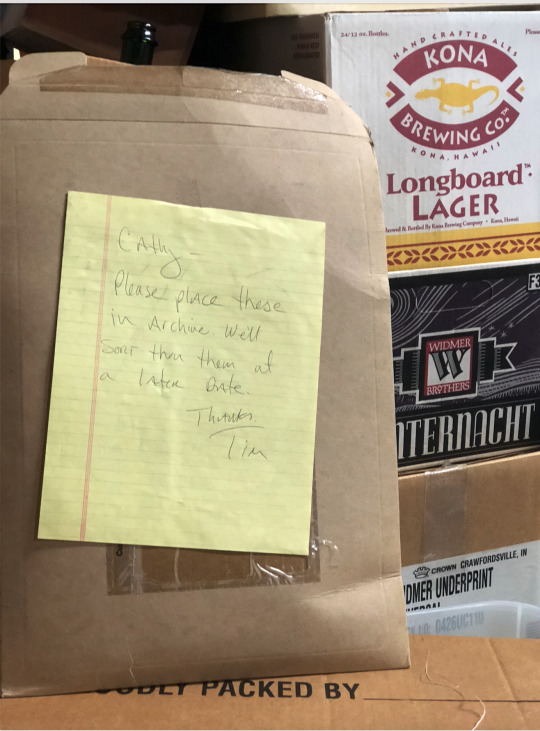





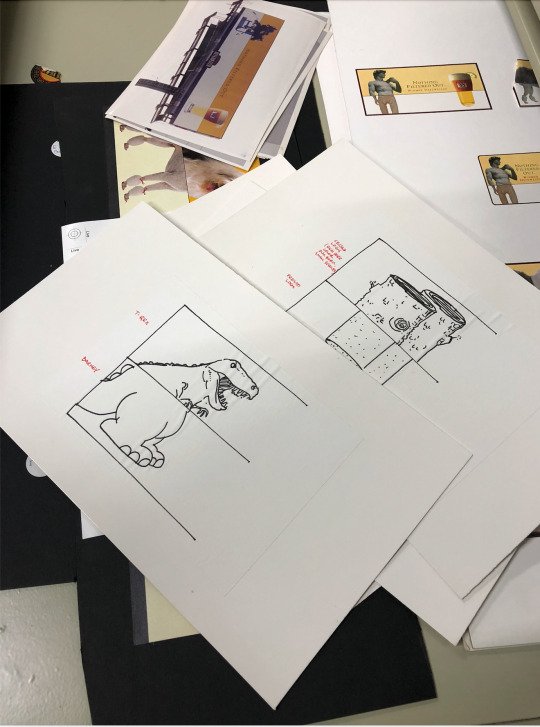
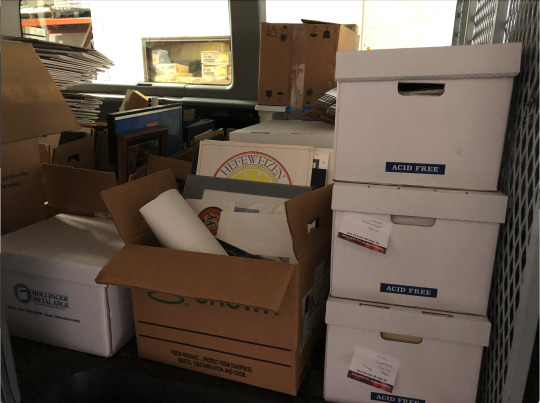
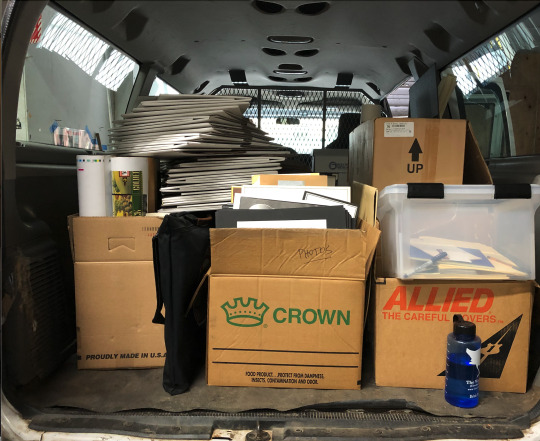

But wait, there's more!
Part 1: The Collection
Part 2: The Company
#widmer brothers brewing#oregon beer#beer history#oregon#widmer#oregon hops and brewing archives#jeff alworth#widmer archives
1 note
·
View note
Text
Collection Report: Oregon Trail Brewery Records, 1951-2020
As we sit in the middle of a heat wave, it's appropriate to report on a collection I got last year in the middle of a heat wave…
I'm excited about the history of the Oregon Trail Brewery, one of the oldest in Oregon and one that has survived a lot to have a new lease on life thanks to Corvallis natives the Picketts, who bought the Old World Deli complex (including the brewery) and have completely remodeled it all.
I was also lucky to connect with Nancy Shadomy, who proofread this guide and gave me some good corrections from what I'd mistyped and what I'd found online (e.g. fermenters came from Canada not Cartwright Brewing in Portland).
Oregon Trail Brewery Records, 1951-2020
Here's what is is in the collection.
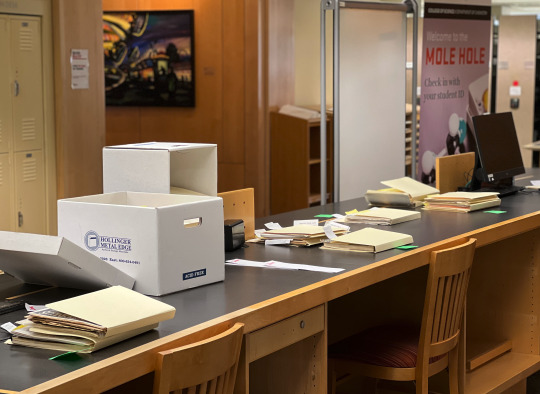
The Oregon Trail Brewery Records document the brewing and company operations, finances and shareholder involvement, transitions to new ownership, marketing and promotion, and reporting about the brewery in the press. Of special note are the brewing records, which include brewsheets from 1996-2020 and brew logs from multiple fermentation tanks at the facility from 2015-2016. Brewsheets and fermentation logs record data about ingredients, temperatures, waste, and other measurements of the brewing process and when the beer is in storage. Also of note is the Brewing Northwest, Ltd. company binder, which includes information about the company and its operations; materials on and for shareholders; licensing and reporting documents for state and federal agencies; information about the Oregon Brewers Guild (1987-1992); documentation of distribution and beer pricing; financial documents (banking, invoices, summary statements) from 1987 to 2005; and marketing materials (labels, newsletters, beer information sheets).
And drawings. Love the drawings.
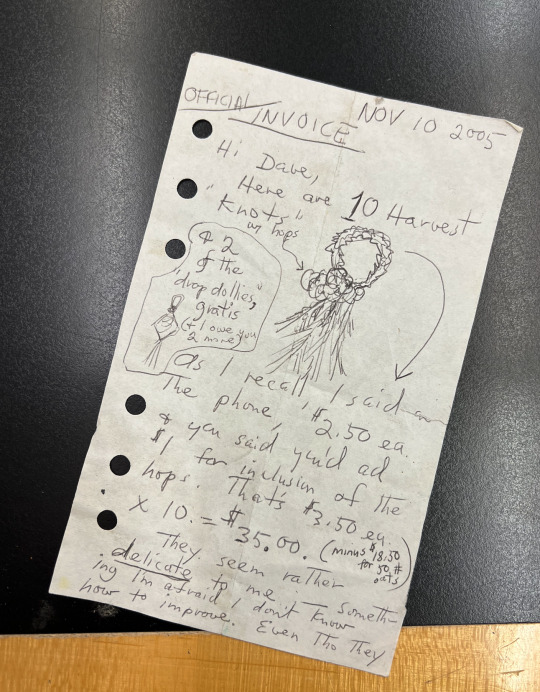
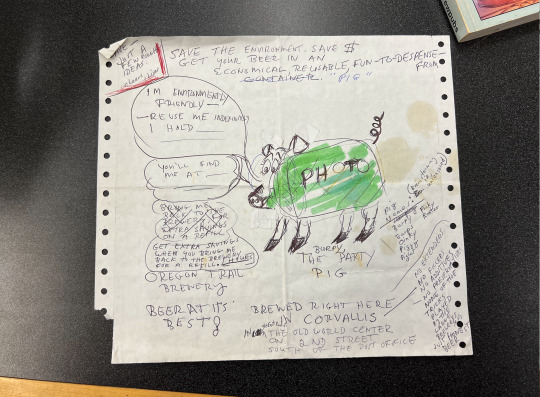
The majority of the brewsheets are from 2004-2014. Numbering resets intermittently without explanation. 1996 and 2001, brewsheets were labeled Brewing Northwest, Ltd.; for those years there are only five sheets and they brewed White, Brown, and IPA. There were beers regularly brewed (White, Brown, IPA, Witbier), new beers added and then regularly brewed (Ginseng Porter, Beaver Tail, Smoke Signal, Bourbon Barrel Porter), and some brewed only for a short time (Gringo, Hop Doctor, Frog). Some brewsheets have notes to Dave Wills about issues or supply needs. The last beer was Witbier brewed August 13, 2020.
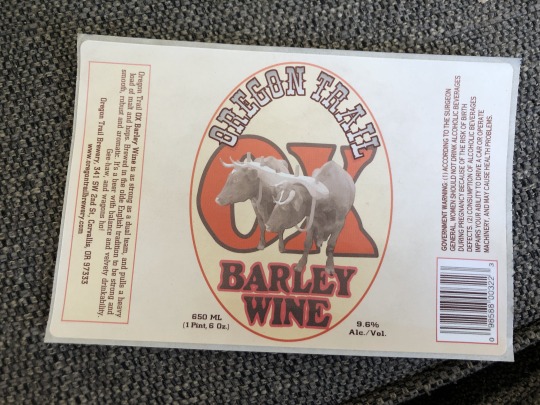
The operational records series contains materials and records related to the creation, administration, and operations of the Oregon Trail Brewery. This includes correspondence, meeting minutes, shareholder lists, licensing and financial information, trademarks, distribution, building documentation, and state and federal alcohol production reports. Of note are materials related to the creation of the Oregon Brewers Guild. The materials in folders 1.21 and 1.22 were removed from a binder titled Brewing Northwest, Ltd: Minute Book and split in two folders for space purposes. Folders 2.01 - 2.06 includes bank statements, cancelled checks, invoices (supplies, equipment, sales), and OLCC summary statements (production, inventory, taxes).
Note: The Oregon Brewers Guild was founded in 1992 and is a non-profit trade, marketing, and lobbying association that represents the Oregon craft brewing industry. Its mission is to protect the brewing industry of the state and the interests of Guild members through education, advocacy, and events.
Note: The Oregon Liquor and Cannabis Commission (OLCC) administers Oregon's Liquor and Cannabis Act and the Adult and Medical Use of Cannabis Act. It promotes the public interest through the responsible sale and service of alcoholic beverages and recreational marijuana products. In 2021, the name was changed from the Oregon Liquor Control Commission to reflect the addition of cannabis under the commission's purview.
Note: The Alcohol and Tobacco Tax and Trade Bureau, statutorily named the Tax and Trade Bureau and frequently shortened to TTB, is a bureau of the United States Department of the Treasury, which regulates and collects taxes on trade and imports of alcohol, tobacco, and firearms within the United States.
The Oregon Trail Brewery Company was incorporated as Brewing Northwest, Ltd. on March 20, 1985 in Corvallis, Oregon and began beer production on July 15, 1987. When Oregon Trail Brewery opened in 1987, it was the first new brewery in the Willamette Valley outside of Portland since Prohibition was repealed in 1933. In 1987, the definition of a microbrewery was a brewer that produced less than 10,000 barrels per year.
The brewery was a "Sub Chapter S Corporation" of the company Brewing Northwest, Ltd. and was financed with shareholder investments. It opened in 1987 at 341 SW 2nd Street, Corvallis, Oregon, in "The Old World Center." Ted Cox was the owner of the building, as well as the owner and manager of the Old World Deli (OWD), which still adjoins the brewery. Cox opened OWD in 1977, ran a homebrewing supply shop in the space, and bought the building in 1986. The OWD complex was called "an improbable blend of faux-medieval architecture, bohemian mini-mall, performing arts space and de facto town square" in 2015.
Jerry Shadomy, the original brewer, co-owned the business with his wife Nancy; they worked with volunteers to transform the back corner of the OWD into a three-story brewery. Beer production officially began on July 15, 1987 under the name Oregon Trail Ale; Jerry used malt from Washington and Wisconsin and hops from the Willamette Valley. Before that, 40-year-old Jerry ran a landscaping business with 35 year-old Nancy and was an award-winning homebrewer. Jerry won Best of Show at the 1986 State Beer Festival. Although Jerry had been brewing since 1980, he had no previous professional brewing experience; nonetheless, they raised over $80,000 from investors, secured a $30,000 loan for operations, and arranged a five-year, rent-free lease with Ted Cox.
Like many early microbreweries, Jerry started with used equipment. He purchased the original 7-bbl brewhouse from Hart Brewing in Kalama, Washington and two of the fermentation vessels came from Canada. The brewery was housed on three levels, with a total of 1,800 square feet, and was set up to take full advantage of gravity at every stage. The top level of the brewery housed a 6-ton malt hopper, which was gravity fed through a roller mill. The malt was cracked and became a grist as it entered the mash-tun with hot brewing water. Their base malt was a two-row Klages and that was combined with smaller quantities of bagged specialty malt as needed. The wort was transferred to the second floor copper kettle and then to the ground floor where the hops were added.
The brewery operated in plain view of the OWD's customers and the deli was the brewery’s first draft account. Jerry focused on traditional English ales, including an Empirical Brown Ale, Oregon Trail Ale, Oregon Trail Chinook Stout, and winter porter. In 1990, Hubert Smith offered an evocative narrative of the brewing process at Oregon Trail. He wrote that "Shadomy ferments warm and matures warm, starting the beer at 70 degrees and aging it for up to four weeks at 50-55 degrees. This permits flavor compounds produced by the ale yeast to infuse the beer with pleasant, subtle, fruity flavors. 'Fruit' in an ale is as much an aromatic as it is a taste, a luscious melding with malt and hops."
Initially, Oregon Trail beers were quite good and the company’s growth was consistent, if still a bit slow. Jerry had good exposure at various festivals, including the then-fledgling Oregon Brewers Festival. However, due to lack of consistent flavor and quality control, they lost many accounts. Shortly after expanding from 300 barrels to over 1000 annually, a series of personal and financial problems collided with unwanted bacterial infections in the beer; this led to a foreclosure of the loan by Cascade West Financial. The brewery closed in October 1992.
On March 14, 1993, Dave Wills, an original shareholder, purchased Jerry's shares and stopped the final foreclosure. Wills served as the President, Secretary, and Chairman of the Board of Directors. He was responsible for finances and oversaw production, sales, and distribution until 2020. In 1983, he had started Freshops, a hop marketing company that supplied hops to small breweries and homebrewers. He was also a Christmas tree grower.

In 1992, Wills hired Jerry Bockmore to serve as brewmaster and company Vice President; he was in that role from 1992-1998. Bockmore was a brewer for Hart Brewing Company in Kalama from 1989 to 1992; he was also the founder of the now defunct Yamhill Brewing Company. When he started at Oregon Trail, Bockmore removed the two open fermentors, which eliminated the brewery’s biggest infection risk. Other equipment changes included the addition of glycol temperature control for the fermentation tanks and the purchase of Zahm & Nagel CO2 and air testing equipment. All kegs were changed from Golden Gate to Sankey to better match what the rest of the industry was using. A thorough cleaning of the entire brewery was all that was left before brewing could begin again.
This all cost money and in 1994 there was a call to increase investments to purchase more equipment, including more fermenters and a bottling machine. At that time, the capacity of the brewery was 91 barrels (182 kegs) per month. At full capacity, the five fermenters at the facility could produce 200 barrels (400 kegs) per month or 2,400 barrels (4,800 kegs) per year. When compared to other breweries in Oregon at that time, their production was approximately 1/3 of Deschutes Brewery and 1/10 of Widmer Brothers Brewing sales in Oregon. At the time of the call for investors in 1994, the Board of Directors floated building a larger brewery in another location and installing a larger bottling line. The move to a new facility never happened, nor did they ever bottle on a large scale. Working in a three-level brewery in a historic building was good for gravity flow, but prevented them bottling beer because of the lack of floor space; instead, Oregon Trail Brewery continued to primarily offer beer in kegs and "party pigs," which are 8.5 liter reusable beer dispensers that kept beer fresh and carbonated.
Bockmore and Wills launched with a Witbier as the flagship beer, which was followed by their Brown Ale. In 1994, the brewery made five beers. Oregon Trail White Ale had been introduced in June 1993 and was a Belgian style wheat beer spiced with coriander and orange peel. In October 1993, they'd introduced Oregon Trail Brown Ale. In December, they produced a seasonal Christmas Ale, which was partially brewed on a contractual basis at the Everett Street Pub in Portland. Oregon Trail Ale, a German style ale (kolsch), had been introduced in February 1994. Oregon Trail Stout debuted on St. Patrick's Day. Nearly 20 years later, in 2012, they still made Witbier and Brown Ale, but had added Smoke Signal Rauchbier (a stronger, smoked-malt version of the Brown), an IPA, a Ginseng Porter (a robust porter infused with American, Korean, Siberian, & Tienchi ginseng), a Bourbon Barrel Porter, and seasonals like Blackberry Wit. In 1989, Oregon Trail Brown Ale was awarded a Beer of the Year award by Fred Eckhardt. Oregon Trail Brown Ale also won silver medals in 1994 at the Great American Beer Festival and in 1995 at the World Beer Championship.
In 1994, they had contracts with four distributors and approximately 40 accounts where their beer was served between Corvallis and Portland; however, they only offered their beer in kegs until 1995, which made distribution and competition with other Oregon breweries difficult. By 2005, they focused on distribution to Corvallis, Eugene, and Newport. They took advantage of the brand name "Oregon Trail" in their labelling, marketing, and beer names. In addition, they had an authentic covered wagon they brought to festivals and occasionally used to deliver beer.
The company continued to have ups and downs for employees and customers. From 1997 to 2002, there were concerns over licensing and serving at beer events; as a result, there was a gap in Wills' involvement and brewery production in those years. In 2003, Don Pfeifer, a retired OSU microbiologist, started working as the Oregon Trail Quality Control Microbiologist, which helped maintain consistency in the beer. Turnover at the brewery was high (nearly a brewer a year), but working there offered OSU students and new brewers an opportunity to work on a manual, and oftentimes challenging, system. Beer was sold at festivals and fairs, on draft at restaurants in Corvallis (Nearly Normals, Squirrel's Tavern) and for a time in Portland (Westside Dublin Pub), through direct sales to the public from the brewery, and at The Old World Deli. The deli was the brewery's main account.

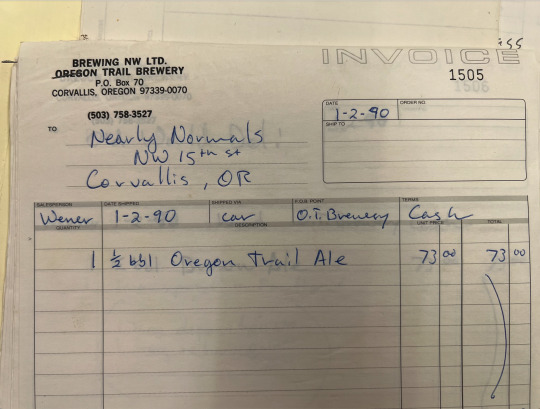
Waylon and Toby Pickett bought The Old World Center in 2020 and reopened it in 2021 after substantial renovations. The Oregon Trail Brewery is owned and run by Waylon's brother, J.D. Pickett.
1 note
·
View note
Text
Collection Report: Rock Bottom Brewery Records, 1994-2010

Just before the 2020 shut down, Van Havig (co-owner / brewer at Gigantic) approached me at the Oregon Brewers Guild annual meeting and said he had 16 years of brewing records from Rock Bottom Brewery. He wanted to donate them to the Hops & Brewing Archives. Yay!
Then COVID...
In summer 2022, he drove two boxes of binders down to Corvallis and mere weeks later I had a guide for the collection done (nearly unheard of speed in archives, but it was perfectly organized and easy). It's a tidy one-box collection, but an interesting look at both standardization and creativity in a corporate brewery.
Rock Bottom Brewery Records, 1994-2010
Here's what's in the collection.
The Rock Bottom Brewery Records document the brewing operations at the SW Morrison Street, Portland, Oregon facility. Brew and kegging logs record data about ingredients, temperatures, waste, and other measurements of the brewing process and when the beer is in storage.
The earliest brewsheet in the collection is batch 11, Pelican Ale. The beers they made didn't change significantly in later years, but brewers were able to experiment with their own recipes and names. In the earliest years (1994-1995), the brewers made five standard recipes: Pelican, Coyote, Brown, Red, and Stout. The sheets in the "Portland Recipes" folder are undated recipes for the early brews. By 2004, they most frequently brewed IPA, Wheat, Amber, Porter, and Lager, but also made Stouts (Irish, Cream, Imperial, and Oat), Kolsch, and Oktoberfest. In 2014, they still brewed IPA, Wheat, Kolsch, but added Belgian, Honey Blonde, Orange Porter, and Rye Stout to their regular rotation.

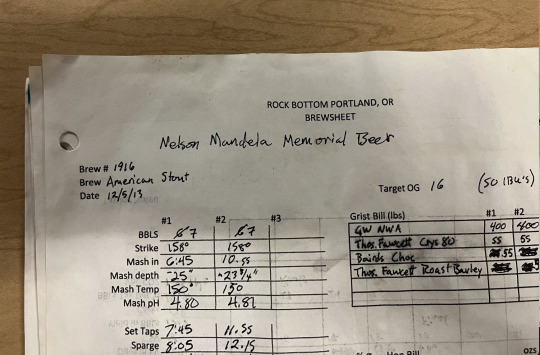
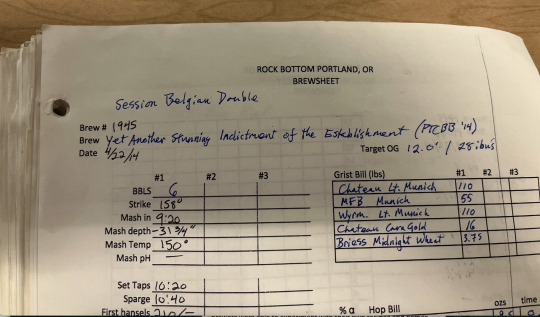


In 2014, they released a "Hipster Beer Series," which included beer names such as "Barley & Me," "Bull Run Red," "Yet Another Stunning Indictment of the Establishment" (a Session Belgian Double), and "Fight Hunger with Beer." Also in 2013 and 2014 were beers called "Yippie-Ki-P-A Motherf***ker," "No Ryegrets," "You'll Shoot Your Eye Out, Kid" (a Christmas Helles), "54 40 or Fight," and memorial beers dedicated to Maya Angelou and Nelson Mandela.
Here's some info about the brewery.
Rock Bottom Brewery is a Denver-based chain of brewpubs. They opened the Portland, Oregon pub in 1994 at 206 SW Morrison Street. It closed in 2019 after the landlord did not renew the lease on the restaurant. Brewers included Matt Sage, Van Havig, Charlie Hutchins, Bolt Minister, Scott Guckel, Pat O'Shea, and Todd Britt.
The chain was founded in 1991 in Denver and rapidly expanded in the 1990s, opening dozens of locations throughout the United States; at that time, businesses that brewed on-site and operated a full-service restaurant were unique. Every Rock Bottom has its own brewer and they could make their own beers based on local market taste. In 2010, Rock Bottom Brewery and Gordon Biersch Brewery were acquired by Centerbridge Capital Partners and merged to form the new CraftWorks Restaurants and Breweries. CraftWorks is based in Broomfield, Colorado.
1 note
·
View note
Text
New hops collection alert! Wigrich Ranche Photographic Album, circa 1915.
Yay for new collections!
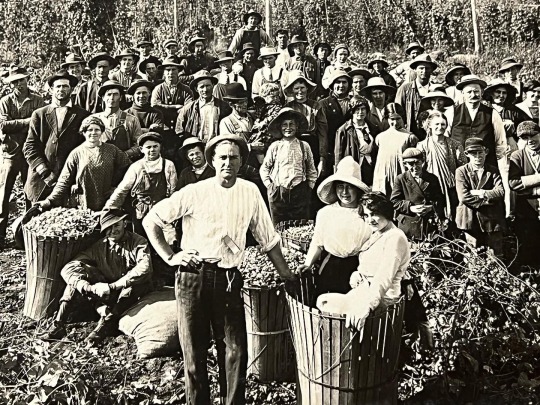
At some point during the 30 years we've been in a pandemic we got this delightful photograph album of the Wigrich Ranche (sic), a hops farm located in Buena Vista, Oregon. It's approximately 3 miles southeast of Independence in an area that was called the “Hop Center of the World” between 1900 and 1940.
Originally known as the Krebs Ranch, the largest hop farm in the state, it was purchased by English hops merchants Wigans and Richardson in 1911, who called the farm Wigrich Ranche, a combination of Wigan and Richardson. In the 1920s, the Wigrich Ranche was said to be the largest hop yard under a single trellis in the world. In 1941, they sold the farm to the Steiner Company, headquartered in New York, and it was renamed the Golden Gate Hop Ranch. It was sold again in 1949 to Herman and Myrtle Moritz and then to Robert Fitts in 1952, who stopped raising hops.

Major W. Lewis Rose, formerly of the British Army, began his work as farm manager in 1913. He was formerly an estate manager in Ireland and in the army with Richardson. He managed the farm until 1928, when he resigned due to ill health; he died in Victoria, B.C. in 1930.
The photo above shows Rose with his wife Charlotte and daughter Winifred in front of their house.
The bulk of the album shows operations and worker activities.

Also included are photographs of large drying kilns, storage sheds, and other equipment; the office of the yard boss; the bakery, restaurant, grocery store, market, dance hall, and blacksmith shop.


There are photos of a newly-planted orchard; plants damaged by a wind storm; bales of hops en route to warehouse storage and being loaded on a train at the Wigrich railroad stop; livestock used on the ranch (Jersey and Durham cows, and Poland Chinese and Duroc Jersey boars).
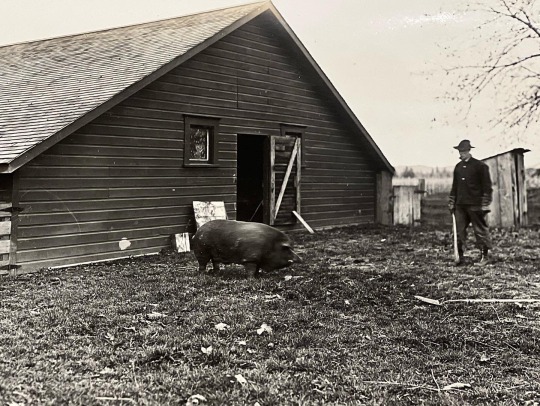
Interior shots include a furnace room with a drying kiln; a tram car loaded with hops entering a kiln; men examining the hops harvest; hops stored in a warehouse, and men preparing bread in the bakery to feed the pickers. There are many photographs of workers, including group-portraits of laborers harvesting hops or transporting them to the warehouse; men in a baling pit; a view of a tent camp and grounds; workers waiting for mail delivery at the post office in the grocery store; dressed-up workers at the dance hall; and workers leaving the ranch after harvest to return home via train or automobile.
One image shows a group of Armenian laborers of the Arslanien Brothers Contracting Co. training newly-established bines (hop vines) in a field.

A series of photos entitled “Twelve Views of the Pickers,” shows seasonal workers divided into twelve groups, many wearing large hats, holding hops plants, pets, bales, etc. Some men are perched on wire fencing. The presence of women and children indicates many seasonal workers brought their families along.
The album is 8” x 12”, with black leather covers and 51 4.75” x 6.75” silver prints mounted on 32 brown leaves. There are 62 photographs. This genre of albums were created to document the operations of businesses; in some cases as a visual record and memento for management, for promotional purposes, or distributed to potential or existing customers. The photographs were taken by the Parker Studio, Salem, Oregon.
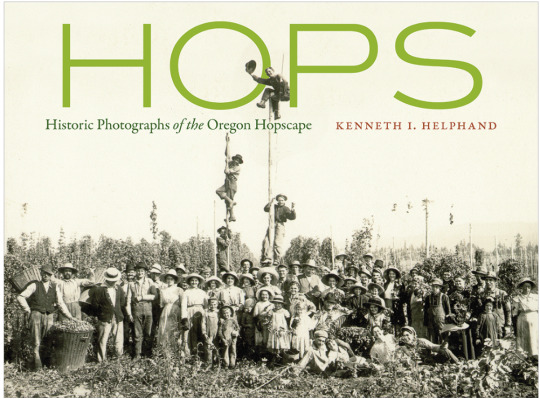
Several of these photographs were used in Kenneth Helphand's book Hops: Historic Photographs of the Oregon Hopscape (OSU Press, 2020). It's a lovely "visual dive into the physical presence of the plant and its distinctive landscape and culture."
3 notes
·
View notes
Text
Pironi and Weinhard [alternate title: It all comes back to Louisa]
This is a story in six parts!
Read the first: Many roads lead to and through the history of beer in Eugene
Read the second: "I furthermore request that my residence never be sold to a saloon keeper"
Read the third: The years of quick turnover at the Eugene City Brewery: August Werner and Henry Hageman
Read the fourth: Mary and Mathias Meller, a short story that could be much longer
Read the fifth: The Vogl Family
Read the sixth: Pironi and Weinhard [alternate title “It all comes back to Louisa”]
Read them all: #eugene beer history
Henry Weinhard bought the Eugene brewery and its companion ice works in 1893 and around 1900 built an ice plant in Springfield (more on this later).
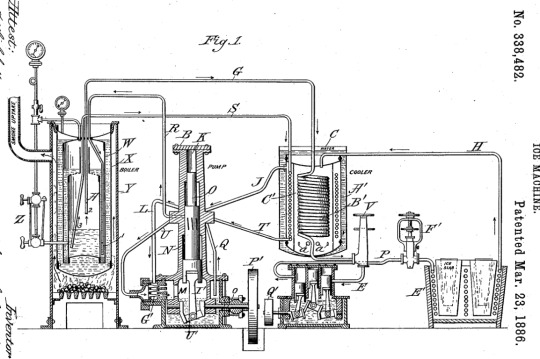
And I include this just because it is a terrific picture.

But for the purposes of Eugene brewing, we turn to Joseph Pironi, who was not a brewer for Weinhard but rather the ice works manager for Weinhard’s Eugene Bottling Works, a job he had until his death in 1912.
Joseph was born in Herstelle, Westphalia, in northwestern Germany, in 1857. He immigrated in 1875 and lived in Baltimore, where he worked as a baker and confectioner until he moved to Oregon in 1879. He settled in Corvallis and again worked in a bakery. While in Corvallis, Joseph married Josephine in 1883. Josephine, maiden name DuBruille, was born February 10, 1864 and baptized in the Catholic Church in Ontario, Canada. She grew up in Corvallis, one of 9 children of Elizabeth and Charles DuBruille; her mother kept house and father worked as a laborer and a farmer. Josephine and Joseph had 4 children; a son (Leo) who worked for the Southern Pacific Railroad in Portland, and 3 daughters (Gertrude, Aileen, Marie) who still lived at home in 1904. Leo served in WWI. She died in 1894 in Portland and was buried in Corvallis (actually just up the hill at the end of the street where I am currently typing this).
After a year in Corvallis, Joseph and August Hodes partnered in a combination bakery and grocery business; they remained partners until 1888 until Pironi sold his interest and moved to Albany. Hodes continued his business for year after.

But before leaving Corvallis, Joseph married Mary in 1883 and they had one child, Henry Paul. Mary, maiden name Scheeland, was born in 1863 in Oregon. She lived with her family in Portland, one of nine children, where her mother kept house and father was a dairyman. Both her parents were born in Prussia, immigrated in 1854 and 1855, and were married in 1856. Interestingly, her mother’s maiden name was Hodes and Joseph had worked for August Hodes (born 1854-1856, immigrated 1871) as a baker in Corvallis. Gustav Hodes (born 1828, immigrated 1860) was a brewer in Orleans in the 1860s. There was definitely overlap in the lives of the Pironis and Hodes: in September 1903, Joseph and Clem Hodes attended a funeral together and in December 1903, Joseph and daughter Gertrude attended Gustav Hodes’ funeral.
In Albany, Joseph purchased the interest of CH Spencer in the grocery business of Spencer & Blackburn, which he ran until 1891. There were issues with credit and debt, and his former brother-in-law took much of the stock as payment. Joseph soon moved to Portland and began work for T. Leebe, a well-known baker, before taking a job at the Weinhard Brewery as a shipping clerk. It’s unclear how much experience in brewing Joseph actually had, beyond the obvious overlap with baking and brewing. While in Corvallis, Joseph was linked to John Riley’s Corvallis Brewery and to the Hodes family, so it’s possible he had more than indicated by his baking and grocery employment.
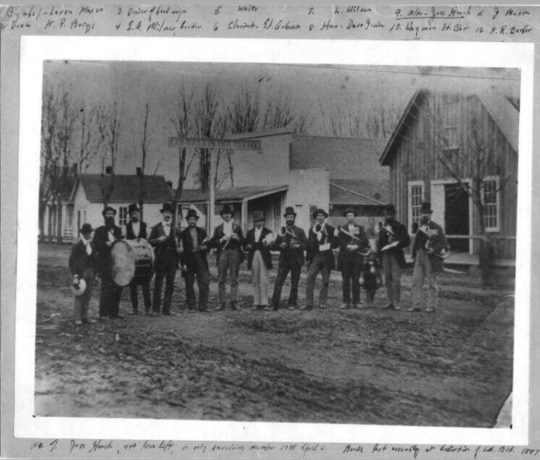
1887: Band on 2nd Street in Corvallis, Oregon (in front of the brewery)
Joseph had different jobs at the Weinhard brewery, but moved to Eugene after an 1899 promotion to manage the ice plant and beer depot, which Weinhard had purchased between 1890 and 1893. The date for the purchase varied in publications, but The Eugene Guard reported on it in March, 1893 with delight at potential for investment in the community; the land was owned by the Weinhard estate for the next 40 years.
The Pironis lived in Eugene for the rest of their lives. They had a new house built in 1911 at 235 East 3rd Street in Eugene, but Joseph died the following year after a 6-month illness.
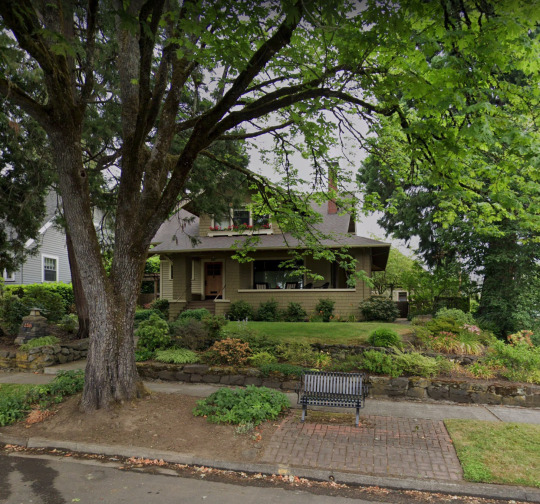
This was the Pironi house in 2020.
Joseph was buried in the Mount Calvary Catholic Cemetery in Eugene and Mary died in 1946 in Eugene of pulmonary edema at 83 years old.
Weinhard never actually intended to brew in Eugene, rather to use this business as a distribution station for that part of the state; he also wanted the ice factory.
A couple of significant things happened for the Weinhard family and their business. Henry Weinhard died in 1904 and Eugene voters approved a local option of prohibition in 1906, shutting down saloons and effectively eliminating the commercial demand for ice. The plant closed within hours of the judge’s order for city prohibition, but reopened almost immediately to provide ice for residents. That demand remained, and the company made ice for many more years.
In 1910, the Weinhard estate purchased the Eugene Vinegar Factory and planned to install a large and up-to-date ice manufacturing plant and cold storage; it faced the railroad tracks, which was appealing for transportation purposes.
In 1912, the estate contracted an architect to build an 80x100’ ice factory and cold storage plant out of reinforced concrete in Springfield, with a cost between $20,000 and $25,000. In 1913, the company was operating the Springfield facility as a beer storage depot, but decided to build the 23-ton ice making plant in conjunction with storage. They discontinued making ice in Eugene in 1918 and in 1919, the Weinhard ice plant in Springfield was leased by the Eugene Fruit Growers Association, which also operated the plant in Eugene. The fruit growers leased it for a couple of years before planning to repair the ice plant.
In reality, the Springfield warehouse sat vacant until 1921 when it was used as a storage house for part of the Lane County hop crop; it was estimated that it would accommodate 5,000 to 7,000 bales of hops. In 1923, the Eugene lot owned by the Weinhard estate was sold.
And so, as promised, it all comes back to Louisa.

Read my Oregon Historical Quarterly article Maybe You've Heard of Her Husband? Finding Louisa Weinhard.
And see the blog post where this slide was first featured.
Sources used:
Historic newspapers (Historic Oregon Newspapers, but also newspapers.com, Chronicling America, and historic newspaper sites from other states)
Ancestry.com
Late 19th and early 20th century books about people and places (mainly on Hathi Trust and Google Books)
Free form searching on the internet (Tavern Trove is good for approximations of dates, but there are also regional history newsletters that are helpful)
Sanborn Fire Insurance maps
0 notes
Text
The Vogl Family
This is a story in six parts!
Read the first: Many roads lead to and through the history of beer in Eugene
Read the second: “I furthermore request that my residence never be sold to a saloon keeper”
Read the third: The years of quick turnover at the Eugene City Brewery: August Werner and Henry Hageman
Read the fourth: Mary and Mathias Meller, a short story that could be much longer
Read the fifth: The Vogl Family
Read the sixth: Pironi and Weinhard [alternate title “It all comes back to Louisa”]
Read them all: #eugene beer history
The Vogls owned the brewery from 1880 to 1891, at which time the business was sold to the Union Cold Storage, Ice, and Brewery Company. So you would think there would be more information about their time as owners?
Not so much.
Michael and Frances Vogl married in Germany in 1865 and the family immigrated to the U.S. in 1878. The 1880 census records Michael as a 58-year-old laborer from Bavaria, who worked as a laborer in Eugene the year he bought the brewery. He and wife Frances, 48 years old and also from Bavaria, lived at 24 Olive Street and had 3 other Vogls living with them, 24-year-old Mary, 22-year-old Joseph (hotel waiter), and 3-year-old Michael. Michael doesn’t appear to be their son, however, since in the 1910 census she reported having had only 2 children and his obituary in 1903 only reported Mary and Joseph.
There is a terrific circa 1880 photograph of the Eugene City Brewery showing “Lewis Burns, Joe Andres, and Joe Vogel” held at the Lane County History Museum, which has the wrong date or wrong names.
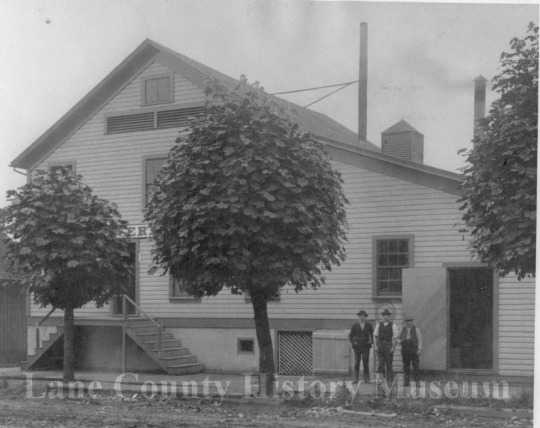
How do I know the names and dates are wrong? Both Louis and his son, the other Louis, were dead by 1883 and Victor was working in Portland as a firefighter. Ignoring the incorrect information, it's still a wonderful photo!
And here's what the building that now stands at 9th and Olive streets looked like in 2020.

I like to think of the overlapping layers of people here – although I am telling the chronological story of this brewery, at the time of that circa 1880 picture, Johanna Behrens, Mary Meller, and the Vogls were all neighbors.

Michael sold the property and brewery to Joseph in 1888 for $1800, and Joseph, in turn, sold it in 1891 to Geo. W. Simons, JL Hoffman and JN Harney, who immediately started raising capital stock of $12,000, with shares to purchase costing $100 each for the “Union Cold Storage, Ice and Brewery Company,” the only ice and storage plant between Albany and Roseburg. Joseph stayed on staff and worked as an engineer, and married wife Jennie in 1892.
Michael and Frances lived on 7th street in Eugene in the 1900, and 82-year-old Michael recorded his occupation as Day Laborer. Michael sold property to “Franziska” in 1902 for $1, and then died the next year in Salem. Frances died in 1912, at 85 years old of “senile decay” and both were buried in the Mount Calvary Catholic Cemetery in Eugene.
Interestingly, Joseph was in the 1900 census twice: once as a brewer living in Mohawk with Jennie and their 2 children, and also as living in Eugene, with the same wife and children and working as an engineer in an ice works. Historically, census counting has been problematic, but Joseph did work for the Weinhard ice plant and beer depot for many years. In both 1910 and 1920, Joseph worked as an engineer in the ice works and in 1911 Jennie was listed in the directory as having a job as an ironer for the Fisher Laundry Company.
Jennie died in 1933 and Joseph in 1944.
Sources used:
Historic newspapers (Historic Oregon Newspapers, but also newspapers.com, Chronicling America, and historic newspaper sites from other states)
Ancestry.com
Late 19th and early 20th century books about people and places (mainly on Hathi Trust and Google Books)
Free form searching on the internet (Tavern Trove is good for approximations of dates, but there are also regional history newsletters that are helpful)
Sanborn Fire Insurance maps
0 notes
Text
Mary and Mathias Meller, a short story that could be much longer
This is a story in six parts!
Read the first: Many roads lead to and through the history of beer in Eugene
Read the second: “I furthermore request that my residence never be sold to a saloon keeper”
Read the third: The years of quick turnover at the Eugene City Brewery: August Werner and Henry Hageman
Read the fourth: Mary and Mathias Meller, a short story that could be much longer
Read the fifth: The Vogl Family
Read the sixth: Pironi and Weinhard [alternate title “It all comes back to Louisa”]
Read them all: #eugene beer history
I'm not exaggerating to say that this could be a series of blog posts in its own right. And also not exaggerating to say that teasing out the genealogy of these two took HOURS and I still don't feel confident in my conclusions about who was related to who and which brewery was run by which person!
Mathias Meller was born in 1841 in Prussia (or Germany) and was a brewer for a short time in Galena, Illinois.
He was part of a brewing family (his father and half-brothers were quite successful brewers in Illinois) and in 1850, he lived with Martin, Eliza, Matthew, Joseph in Galena (clearly their names were "Americanized" a bit). I noticed that he was much younger than his siblings (11 years younger than Joseph), but figured out that this was because the brothers did not have the same mother (the elder Matthias had 3 wives). In 1860, Mathias lived with brothers Joseph (and Joseph’s family) and Mattias (who later went by Matthias) and in 1870 with Joseph (and his wife Theresa) and, according the census records, his future wife, Mary Haser, who was born in Illinois in 1853.
Here's where the things get really tangly.
Mary could have been Theresa Meller’s older sister or her niece. The Meller’s next door neighbors were the Hasers, and at the time Joseph Haser was the Galena city mayor. Joseph and wife Margaret did not have a daughter named Mary, so Joseph might have been her older brother or uncle. Further proof of Mary not being their daughter is that Margaret was born in Iowa and according to the 1880 census, Mary’s mom was born in Ireland. The families tangled more.
In the 1880 census, Joseph Haser listed his occupation as “beer manufacture” and was partnered with Joseph Meller in the Franklin Brewery from 1860-1864 (except when Haser was mayor).
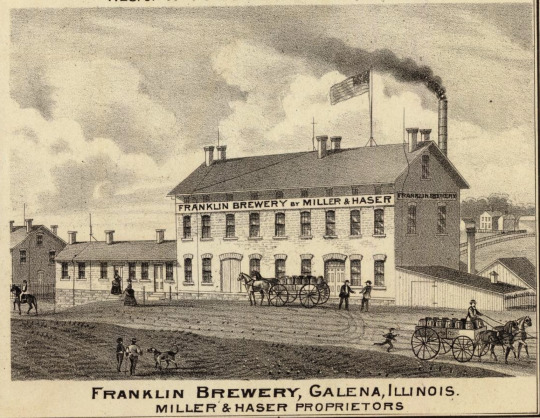
From the 1876 Banks, Residences and Breweries in Shawneetown, Galena and Massac Co., Ill.
Other brother Matthias was also quite successful, running the Fulton Brewery, home of Red Stripe Beer, from 1860-1885. Here it is in 1880.

Back to our Eugene beer story.
The Mellers married in 1874 in Illinois and had moved to Eugene by 1876, when Mathias bought the brewery. In the 1880 census, Mathias was a brewer and they had a daughter, Mary. The Mellers had already lost two children by that census and later that year Mathias was dragged to death by a cow.
His estate was valued at $2500, but debts were high enough that real estate had to be sold to cover them. Mary was savvy in terms of how to live off the business for a little longer: the terms of sale of the brewery property were that the new owner, Michael Vogl, would put 1/2 down at the time of the sale and pay the remainder in the next year at 10% interest. Mary also insisted that the brewery items not be sold separately because they had more value when combined with the building. It’s difficult to estimate how much the business had grown in the 10 years since Johanna had sold it and Mathias died. There is an estate record for Henry Hageman, which I haven’t yet seen, so that would certainly be a benchmark at least 5 earlier, but as a reminder, Johanna sold the brewery to August Werner for $3000, Werner to Hageman for $1500, and Hageman’s estate to Matthias for $900. So, it was not significantly appreciating in value…
Vogl bought the brewery and all its equipment in February 1881 for $1400. Again, as it was in Johanna’s probate record, Mathias’ gives good details about the business operations. Equipment and supplies included 35 5-gallon kegs, eleven 10-gallon kegs, seven barrels, 24 dozen bottles, a 50-foot hose, eleven faucets, a brass stopper, twenty cords of wood, a horse and wagon (combined $130), a harness and cooper’s tools, a grind stone, 75 staves, several tables and stools, a stove pipe, a clock and a looking glass, 9 beer tumblers, 200 bushels of barley (worth $120), 10 bushels of malt, 5 pounds of hops, and 3 barrels of beer (worth $30).
After the estate was settled, only $516.67 remained, but the items in their home were valued at $600 (compare this to the things in Johanna’s home, valued at $200 the following year).

I'll note that Mary’s house was two doors down from the lots owned by Johanna and across the street from her house.
The personal property listed in the Meller home included a cooking stove and warming stove, bedstead and spring, chairs, a dining room safe, 10 cords of wood (ash, worth $30), a walnut bedroom set (worth $60) and walnut center table, a baby carriage, sewing machine (worth $25), 35 yards of carpet, and 9 pictures. Mary asked to have these items removed from the consideration in the estate inventory since she and daughter Mary still needed them, and also asked for $30 per month from the estate for living expenses; the lawyers suggested she sell the belongings and use that money for her expenses. She didn’t.
However, four years later, in 1884, Mary died of “brain fever.” She was survived by their daughter, Mary Therese, who was taken in by Gertrude De Lin, a friend and resident of Multnomah County (so not any of the people tangled up with each other in Illinois). Her obituary called her “highly esteemed and beloved by her many friends,” noted she “had a pleasant and loving disposition,” and said she “was always present in the sick room of friends to administer to their wants.” She was buried in Eugene Masonic Cemetery, noted as a place where prominent citizens were buried.

Her estate was valued at nearly $3000, which was more than Mathias’ estate had been worth four years earlier.

The inventory of the household goods was also more detailed than Mathias’ inventory, which makes me wonder if household items were given more value or attention in a woman’s estate. There was overlap, including the walnut bedroom set and Singer sewing machine, but also more details. The heating stove had a pipe, the cook stove also had cooking utensils, there was a hair or wool mattress and a feather bed, there were six lace curtains and 1 ½ cords maple wood. I was also interested in the picture the details about the dishes and miscellaneous kitchen equipment painted, one that told me that she made things, entertained, and had money to buy specialized items; there was a rolling pin, potato mash bowl, fruit jar knife, castor knives and forks, butter dish, spoon holder, stone jar, pitcher, teapot, and six goblets. She had two certificates of deposit worth $60 and $40, and four people owed her approximately $1500. Gertrude De Lin would receive $10 a month from the estate for Mary, and the estate would be totally liquidated to do this.
There was a phrase similar to Mathias estate: “reasonable allowance according to the circumstances and condition in life of said minor child.” I interpreted this as a marker that the family had a certain standard of living, and it was expected that their daughter would continue to have that, but it’s unclear what happened to their daughter as she grew up.
Sources used:
Historic newspapers (Historic Oregon Newspapers, but also newspapers.com, Chronicling America, and historic newspaper sites from other states)
Ancestry.com
Late 19th and early 20th century books about people and places (mainly on Hathi Trust and Google Books)
Free form searching on the internet (Tavern Trove is good for approximations of dates, but there are also regional history newsletters that are helpful)
Sanborn Fire Insurance maps
0 notes
Text
The years of quick turnover at the Eugene City Brewery: August Werner and Henry Hageman
This is a story in six parts!
Read the first: Many roads lead to and through the history of beer in Eugene
Read the second: “I furthermore request that my residence never be sold to a saloon keeper”
Read the third: The years of quick turnover at the Eugene City Brewery: August Werner and Henry Hageman
Read the fourth: Mary and Mathias Meller, a short story that could be much longer
Read the fifth: The Vogl Family
Read the sixth: Pironi and Weinhard [alternate title “It all comes back to Louisa”]
Read them all: #eugene beer history
We left off with the death of Louis Behrens in 1871, will of Johanna in 1882, and sale of the brewery in between. Johanna wrote a prohibition against selling her property to a saloon in 1882, but regardless of how she felt at the time of her death, after Louis’ death she sold the business for $3000 to August Werner, who was a brewer and retailer of liquor and tobacco.
In 1873, Werner sold the Eugene Brewery to Henry Hageman for $1500, half of what he'd purchased it for only two years earlier. The Oregon State Journal said “this is certainly very cheap, as the property has not depreciated in value during the past two years.”

Was Werner a brewer? The evidence is inconclusive. In the 1871/1872 Pacific Coast Business Directory, Louis was listed as a brewer in Eugene, but Werner and Hageman were not. There was, a Henry Hageman listed as a brewer in the 1870 Boyd's Directory of the District of Columbia, so it is possible he moved to Oregon with those skills.
Hageman advertised his lager beer as “of a superior quality” and reminded customers that “A good article needs no recommendations.”

The next year, he claimed to “manufacture the best beer and malt to be found in any town in Oregon” and assured people that he both understood his business and wanted to give his customers everything they wish.
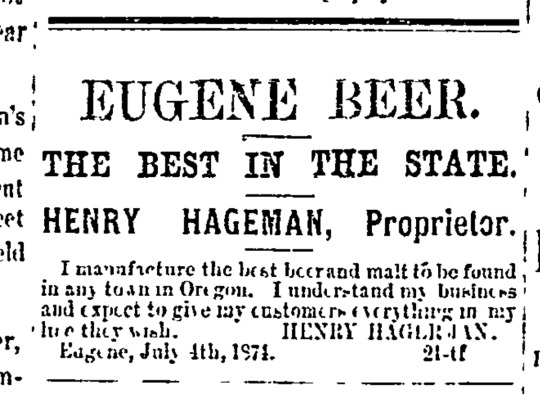
He did have some regional competition: that same edition had an ad for John Rast’s Roseburg Brewery, which he called the “No. 1 Lager Beer.”

Notably, John Rast's wife Clara was a charter member of 1895 Mental Culture Club, which was strongly pro-Temperance. And it is rumored that she put a restriction similar to Johanna Behrens in her will regarding the prohibition of sale to a liquor establishment.
In 1873, Corvallis Brewer Charles Stein opened a saloon to act as the Eugene depot for the Corvallis Brewery.

Whether Henry Hageman would have become a household name for brewing history is speculation because he died in a brewery accident one evening in April 1875. He was working over a well-filled mashing tub, 5 to 6 feet deep, which at the time was boiling; he stepped wrong on a board and ended up in the tub. Victor Behrens, who worked there at the time, got him out as soon as possible, but he was so badly scalded he died later that night.
The brewery was put up for sale, again, in February 1876. Though the newspapers called it “a desirable property” and “good chance for a bargain,” the initial highest bid was only $880. The rental for the property was $240 per year and improvements needed to be made before a sale, the bid was deemed “insufficient” and the sale postponed until mid-March, when the brewery was sold at public auction to Mathias Meller for $900. This was enough to settle Hageman’s debts. The sale notice said Meller already owned “all the movable appliances,” so he was equipped to start brewing immediately.
Sources used:
Historic newspapers (Historic Oregon Newspapers, but also newspapers.com, Chronicling America, and historic newspaper sites from other states)
Ancestry.com
Late 19th and early 20th century books about people and places (mainly on Hathi Trust and Google Books)
Free form searching on the internet (Tavern Trove is good for approximations of dates, but there are also regional history newsletters that are helpful)
Sanborn Fire Insurance maps
0 notes
Text
"I furthermore request that my residence never be sold to a saloon keeper," Johanna Behrens
This is a story in six parts!
Read the first: Many roads lead to and through the history of beer in Eugene
Read the second: “I furthermore request that my residence never be sold to a saloon keeper”
Read the third: The years of quick turnover at the Eugene City Brewery: August Werner and Henry Hageman
Read the fourth: Mary and Mathias Meller, a short story that could be much longer
Read the fifth: The Vogl Family
Read the sixth: Pironi and Weinhard [alternate title “It all comes back to Louisa”]
Read them all: #eugene beer history
When we left the Behrens, they lived in Oregon City, where Louis worked as a brewer and Johanna kept house. I haven’t found the location of the brewery yet, so I’m not sure how close they lived to it, which may help gauge what the level of overlap between home and brewery or Johanna’s day-to-day role in brewery operations might have been.

Photograph from the Clackamas County Historical Society.
The 1880 picture below gives a slightly different perspective, but it’s difficult to tell whether there was a dwelling nearby then or when Johanna lived in Oregon City.
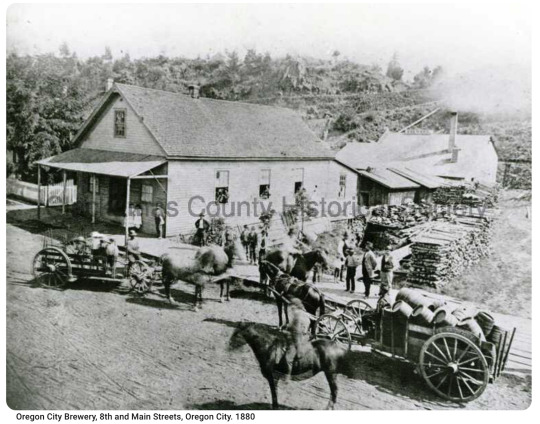
Photograph from the Clackamas County Historical Society.
One more odd tidbit of an overlap: the Oregon City Enterprise announced the opening of a brewery, in Oregon City, by Henry Humbel, who’d recently moved there from Idaho. His wife at the time was Theresa, who later divorced him and co-owed a brewery in Astoria.

In Theresa's own words from their 1870 divorce records: “I drank wine with Mr Humble before I married him. It was my suggestion of going into the brewery business.”
The first advertisement for the Eugene City Brewery was in July 1867, and stated Louis was making ale, porter, and lager beer, and “selling at price to suit the times, for cash, or will exchange for barley.”
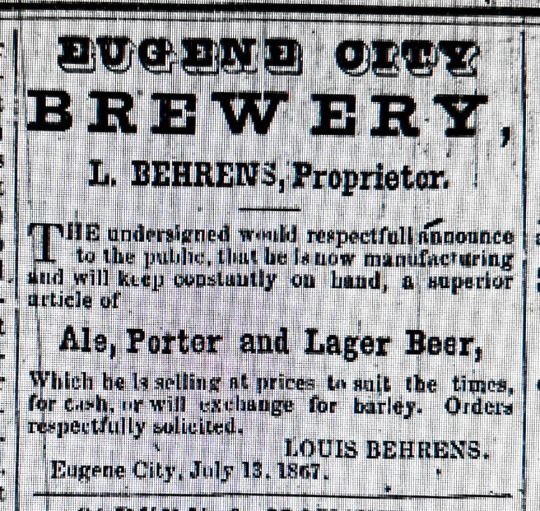
In the same edition, there was an ad for the Lager Beer Saloon, run by the Coleman Brothers, which provides interesting information about what was being sold at saloons in Eugene. Their bar was always stocked with whiskey, rum, gin, schnapps, Hostetters [stomach bitters], Hoofland’s [German stomach bitters, nonalcoholic unless “tonic,” which had Santa Crus rum], tonic, brandy, wine, lager, and “any and everything that is ‘good to take,’” but also had a “large and full stock” of oysters, sardines, nuts, confectionaries, cigars, tobacco, Meerschaum pipes, toys, and “fancy goods.”
The 1870 census reflects their move to Eugene, where they had an estimated personal estate value of $1000 ($22,000 in 2022), a decrease from the decade before, and 4 children with the birth of Louis O. in 1861.
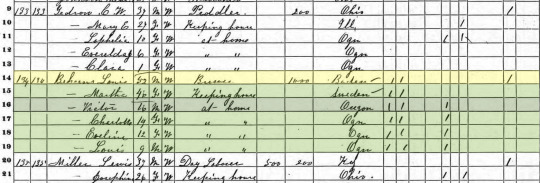
What about brewing in Eugene?
In 1867, the editors of the Eugene Register Guard thanked 13-year-old Victor in 1867 for bring them “a bucket of splendid lager this week” and proclaimed the ale and lager made by the Eugene City Brewery as good as any other brewery in the state. In the “buy local” sentiment that would be omnipresent in the 21st century, they said “there is no longer and excuse for patronizing Corvallis. Encourage home enterprise and industry.” In an 1869 advertisement the Corvallis Brewery, proprietor Joseph Hunt called into question the quality and safety of Louis’ beer: “The public are assured that I brew on the square, and that everything in my line is pure. If you want ‘fish berries’ and other poisonous compounds don’t buy of me. If you want a health insuring beverage, send along your orders, and you can then ‘laugh and grow fat.’”

Hunt made sure to let Eugene residents know they could find his beer at the Arcade Salon.
In 1867 and 1868, Louis was taxed as a distiller, likely making barley malt whiskey, though none of his brewery ads include liquor. He registered the name Eugene City Distilling Company in late 1868 or early 1869, and his peak year for whiskey production was 1869. Concurrently, there were lawsuits being litigated. In 1868, two circuit court suits were brought against Behrens, including one by Peter Blake to foreclose on a property and a sheriff’s sale to pay debts.
There was a period in 1868 where there were no newspaper advertisements for the brewery: was this because of financial difficulties or the closure of the business due to these lawsuits?
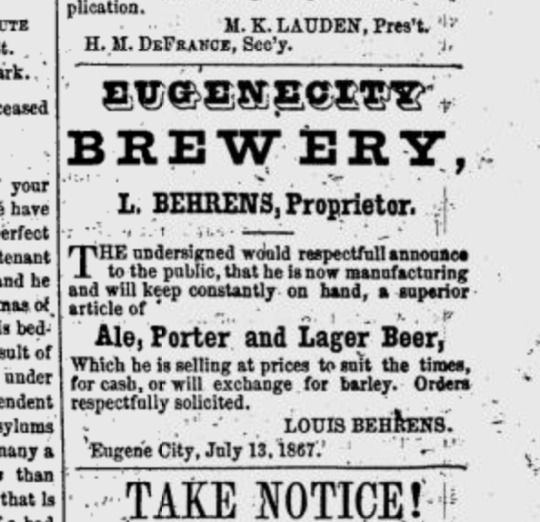
The last Eugene City Brewery ad with Louis Behrens as proprietor was January 30, 1869 and then something curious happened, the name on the ad changed to Johanna’s. In an ad dated August 21, 1869, customers read that the brewery always had lager on hand, “for sale cheap, in small and large quantities,” with J. Behrens followed by L. Behrens, who was the agent.
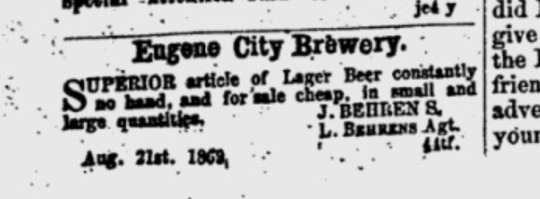
Behrens’ health probably began to fail in 1869 and the brewery stopped advertising entirely in August 1870. Louis was still listed as the brewer in tax lists for June 1870 and 1871 and was listed as a brewer and retail liquor agent in the 1871 Pacific Coast Business Directory. Louis died November 8, 1871 of dropsy and was buried in Eugene Pioneer Cemetery.
And so, this question remains unanswered: who was running the business? The “L.” in the advertisement could be father or son Louis, but it is also possible lawsuits or illness meant the elder Louis wasn’t involved at all. And it is impossible to not to flash forward to the statement in the title of this post from Johanna’s 1882 will: “I furthermore request that my residence never be sold to a saloon keeper.”

Johanna married James Goodchild at her home in June 1879. James was a gardener and his first wife, Sarah, had died in England. In the 1870 census, his personal estate value was $10,000 ($200,000 in 2022) and real estate value was $800 and ten years later, in the 1880 census, Johanna and James lived with 18-year-old Louis in Eugene. They weren’t married for long: James died in January 1881 at 66 years old and Johanna died the next year, September 24, 1882, at 58-years-old. Son Louis died in a railway accident in May 1881, so her remaining three children Victor, Lottie Ralston, and Clara Severns divided the property equally between them. Her real and personal property was valued at $2000, but considering debts the total estate was valued at $1000. Her personal property allows for some imagining about what their house was like.

It was valued at nearly $200, and included four tables (round, dining, kitchen, stand); five safes (clothes, dish, meat, flour); 5 yards two ply carpet, 15 yards three ply carpet, 46 yards rag carpet; several chairs and stools; 3 stoves (parlor, box, cooking); various pieces of furniture including a leather-bound trunk and a marble washstand; seven cabinet sized rustic frames and nine framed pictures; two looking glasses. There were two feather beds, a bedstead and wire mattress, a mattress, a cottage bedstead, nine feather pillows, five bed blankets, and six quilts. She had 3 1/2 cords of wood, 46 cans of fruit, and 10 pounds of dried fruit. There were tools like a mattock and a crowbar, two spades, five rakes, and a bucksaw. She owned one and a half dozen chickens, miscellaneous tableware, and a “whatnot.”
It ends with an intriguing caveat, the title of this post, as it related to property: “I furthermore request that my residence never be sold to a saloon keeper.”
This raises questions about what her experiences had been being married to a man who was one of the earliest brewers and distillers in Oregon, but one that died at 53.
Sources used:
Historic newspapers (Historic Oregon Newspapers, but also newspapers.com, Chronicling America, and historic newspaper sites from other states)
Ancestry.com
Late 19th and early 20th century books about people and places (mainly on Hathi Trust and Google Books)
Free form searching on the internet (Tavern Trove is good for approximations of dates, but there are also regional history newsletters that are helpful)
Sanborn Fire Insurance maps
0 notes
Text
Many roads lead to & through the history of beer in Eugene
Alternate title: Eugene beer, a story in six parts
Read the first: Many roads lead to and through the history of beer in Eugene
Read the second: “I furthermore request that my residence never be sold to a saloon keeper”
Read the third: The years of quick turnover at the Eugene City Brewery: August Werner and Henry Hageman
Read the fourth: Mary and Mathias Meller, a short story that could be much longer
Read the fifth: The Vogl Family
Read the sixth: Pironi and Weinhard [alternate title “It all comes back to Louisa”]
Read them all: #eugene beer history
I've been doing a deep dive into the history of pre-Prohibition brewing in Eugene, but now I have the luxury of onsite research that alluded me during the lockdown days. It also got me back to the microfilm.

And.

In addition to my book research, I’m preparing for a tour for the 2022 American Society for Environmental History conference, which includes visits to AleSong and Wild Craft Cider and a much-abbreviated telling of the six-part story I'm going to pose here.
The pre-Prohibition era story of Eugene brewing deftly illustrates the movement of brewers, the collaboration and business partnerships, and hints at the regional competition between them. As I do in much of my work, I want to show the influence and impact brewing had on the families, especially the women, and often that is also just in a hint or a suggestion – a decrease in the value of family property, lawsuits, language in wills, items in a probate record. And sometimes it is more than that, as was the case in Johanna Behrens will, which included the directive that her property could not be sold to a saloon keeper.
The story of the brewers in Eugene is also unique because we can trace the lineage of one brewery through many hands.
Here’s a Sanborn map from 1884, the earliest I’ve found, that shows the layout of the brewery.

And one from 1902, when it had changed hands and become a Weinhard’s beer and ice depot (bonus candy store and restaurant above).

There was another brewery in Eugene, the Bavaria Brewery at the NE corner of 7th and Olive (where a parking garage is now).
Here it is in 1885.
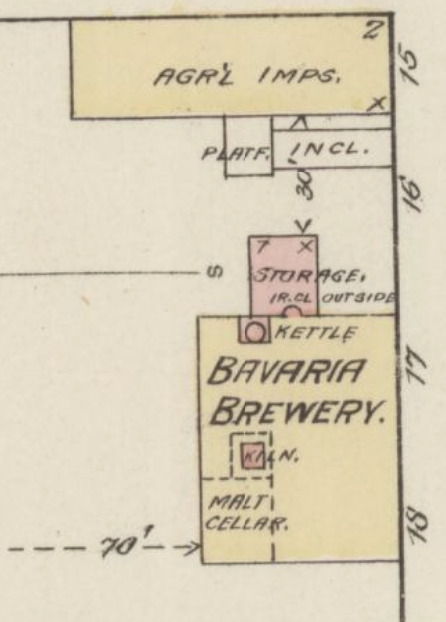
And in 1890 when it had a saloon attached.
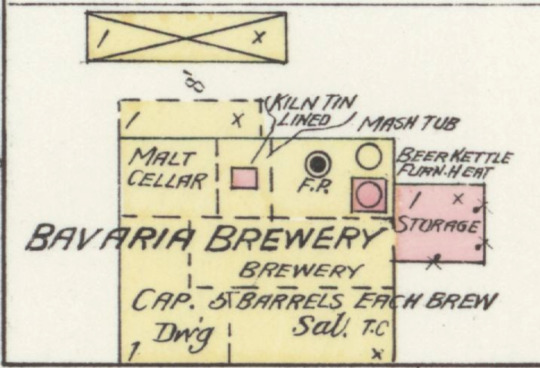
It was run by Eugene Wiedeman, who lived in Corvallis and Eugene with his wife Johanna [Meyer/Maier, Deckenbach] and their kids. In addition to the brewery in Eugene, which he ran from approximately 1885 to 1891; in 1895, Wiedeman died of a heart attack at 42 years old on the street in front of their house (also at the corner of 7th and Olive) and his obituary said he’d been engaged in the brewery business in Eugene for 11 years (1884-1895). He also had a brewery in Junction City from 1884-1888. After Eugene’s death, Johanna moved to Portland, where she ran a boarding house until she died in 1927.
Back to the Eugene City Brewery, which was started by Louis Behrens in the 1860s and, ultimately, closed by the estate of Henry Weinhard in the late 1910s. And, in considering these two men, it is also noteworthy that they both started brewing in the Portland/Oregon City/Vancouver area at the same time. But their lives and companies took very different directions in terms of revenue and business longevity.
One thing to note about how I refer to people. Under normal circumstances, I would always use last names rather than the less formal and more familiar first names; however, when I talk about people who were married, it becomes confusing quickly, so I refer to them by first name.
THE BEHRENS
Johanna Storm was born in 1823 in Stockholm, Sweden, and she married brewer Louis Behrens in 1852. Louis was born in 1818 and sources conflict about his place of birth either Baden, in Germany, or Bern (there’s one in both Germany and Switzerland). Unlike most other brewer families, Louis and Johanna probably immigrated directly to Oregon (though likely not together) and he had an 1851 Donation Land Claim in Oregon City.
On April 1856, George Flanders sold 4 lots in Portland to Henry Saxer and Louis for $350 “together with all and singular the apparatuses thereunto belonging.”
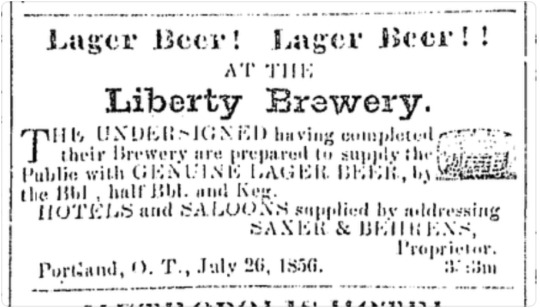
The Weekly Oregonian featured their first joint advertisement for the Liberty Brewery in July 1856, but just six months later, there was a dissolution notice for the partnership and notice that Saxer would continue the business in the same location.

Learn more about brewing in Oregon and why Henry Saxer didn’t open the Liberty Brewery in Portland in 1852 in my Oregon Encyclopedia essay.
It’s unclear what Behrens did in the intervening years, but in May 1858, he placed an advertisement for a new brewery at Railroad and 8th Street in Oregon City.

He was also involved in local politics, namely in protesting an early move to ban alcohol, even before Oregon was a state, with a particular focus on beer.
“On Tuesday scarcely anything could be heard on the streets and in all the stores where groups were assembled, but arguments on lager beer. The gold excitement is entirely swamped by it. Such was the public interest in the debate that the Court-house was crowded to overflowing by men and women who manifested, their pleasure by tremendous cheers at regular intervals through a debate that lasted till half after ten o’clock. This time, Louis, who keeps the lager beer brewery, came to our relief, and made a speech on the negative. The anti-beer men were dissatisfied with the result, and the debate was adjourned over to next Monday night. We hear that the anti-beer men are talking of sending abroad for help.” The Oregon Argus, 7/24/1858
In a letter dated February 9, 1859, less than a week before Oregon became a state, Louis wrote to the staff at The Statesman and reminded them they “know how to appreciate a good article of Lager Bier,” and “that editors, printers and devils are always thirsty,” so he sent them a keg. The staff thanked him for the present, called him a friend, and assured that they had “toasted him with bumpers filled to the brim.” The article concluded with this statement: “Lager is ‘the cup that cheers but not inebriates.’ And Louis is an adept in the matter of ‘the brew,’ and too honest to conduct that venerable institution any other way than ‘on the square.’” His honesty was on display later in the summer, when he was passing by the city jail early one morning and stopped a jail break.
In 1860, the Berhrens family lived in Oregon City, where Louis continued his work as a brewer. Notice that they lived next door to A Speelman, also a brewer, his family, and a barkeeper.

They had 3 children, Victor (6), Charlotte (4), Evelina (2), lived in a house worth $7500 ($256,000 in 2022), and had a personal estate valued at $1000 ($35,000 today).
There are some clues about what life in Oregon City was like for them. In 1860, there was a fight between two men at the brewery one afternoon in May, “in which glass tumblers and stones were pretty freely used” and one man drew a knife on the other man, who “took refuge in Judge Caufield’s store by jumping through the window.” At the 1861 Oregon Agricultural State Fair, Johanna contributed home-made bread. There were other submissions for “fine butter – fresh, and in the firkin” and “specimens of fresh butter,” as well as cheese, one block weighing between fifty to sixty-five pounds, wine from Oregon grapes supplied up by Mr. Keil of Aurora, and flour from the Standard, Oregon City, Island, and Mill Creek mills.
Read about the overlap of Louisa Weinhard and the Aurora Colony in my Oregon Historical Quarterly article about her!
Sources used:
Historic newspapers (Historic Oregon Newspapers, but also newspapers.com, Chronicling America, and historic newspaper sites from other states)
Ancestry.com
Late 19th and early 20th century books about people and places (mainly on Hathi Trust and Google Books)
Free form searching on the internet (Tavern Trove is good for approximations of dates, but there are also regional history newsletters that are helpful)
Sanborn Fire Insurance maps
0 notes
Text
Margaret Beck and the lawsuits
This is the third post from a talk I gave December 16 for the Willamette Heritage Center as part of their “Zooming Back to History” series.
Read the first post “What do we do with data?”
Read the second post Mrs. Beck, “lady of culture and refinement” with a “keen discrimination in matters of trade.”
Read all my posts about Margaret Beck.
Thanks to the Salem Public Library for the brewery photo below. The picture of Samuel Adolph, who you’ve already been introduced to, is from ancestry.com. Ignore the weird reflection.
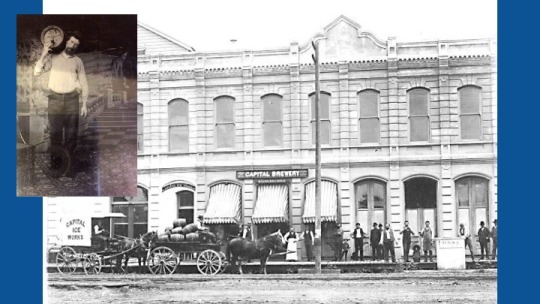
Here’s the story of the business that became the Capital Brewery: In 1866, Samuel Adolph founded his brewery in Salem, initially called the Pacific Brewery. The business was destroyed by fire in 1869 and he relocated and renamed it the Salem Brewery.
In 1885, Adolph sold the business to Seraphin Beck and Maurice Klinger, and they renamed it the Capital Brewery. They purchased a lot across the street and built a larger brewery and ice works, which by 1891, had an annual output of 3,500 barrels. They also had a small bottling plant. In addition to the brewery, which produced mainly draught beer, they had a saloon with a sawdust floor that sold beer by the keg, quart, or glass.
A 1930 article gives us clues about Salem saloon culture. It reported that there “were all classes of saloons, kept by different classes of men; from those who catered to the lowest trade to men who regarded their reputations for obeying the laws and observing the amenities of well-regulated society. But the bar of Klinger & Beck … was different. It was not a saloon, or not regarded generally in that class … the best men in Salem slaked their thirsts there” and gathered to “talk politics … swap stories, and partake of the generous free lunches that were set out.” Here’s another one from 1946: “A bartender was employed and in the pleasant quietude of Klinger & Beck's taproom gathered serious lawyers, bankers, politicians and business men to ponder and settle their problems.”
Of course, for the most part, women were not welcomed in saloons. The explanation would have been that these were rough places with drunk men that would tax a lady’s propriety. But when I read the descriptions of the Capital Brewery saloon, I was struck by the fact saloons were where politicians and businessmen made deals and effected change in the city. It’s where information was shared and people gained knowledge. And women were not a part of that conversation. So, what would it have been like for Margaret Beck to live adjacent to this business, and then run it, but to have not been a part of the clientele?

I love this ad. I have lots to say about this ad. But this talk is not about ads.
If you want to know more about women in 19th century ads, I wrote a 6-part blog post series about just that.
The short story about how Margaret Beck took over the brewery is this: Seraphin died in 1899 and the property sold at public auction, which Margaret bought with a $29,000 bid. Ben Maxwell offered a rosy version of the story in 1946: “Seraphin Beck died about 1900 and for a time Mrs. Beck and Klinger operated the plant. In 1901 sold to Mrs. Beck and she, in 1903, sold to the Schmidt’s.” In 2005, there was a similar sentence: “Beck died in about 1900, and, for some time, his widow operated the plant with Klinger. Soon after, Klinger sold his interest to Beck's widow.” The longer story is that there was a protracted legal battle about Seraphin’s estate.
The estate had two executors: E. Schott, a saloon keeper from Sublimity who was in charge of a personal estate valued at approximately $1000, and Maurice Klinger, who was the executor of the partnership property estate, which was appraised at just over $41,000. Maurice owned an undivided half interest in the estate, while Margaret’s kids each owned one quarter.

Six months after the executors were named, Margaret filed charges against Schott and asked the court to appoint her administratrix of the estate. She had a list of twelve complaints, including that he hadn’t filed required reports, failed to inventory the estate, hadn’t collected rent due to the estate, and that he did not “possess the business capacity and qualifications necessary for the proper management.” He was also a jerk to her – he was unfriendly “and is arbitrary and domineering with her when she endeavors to consult and advise with him concerning the business of administering upon the estate” and shortly after his appointment as executor told Margaret to “shut your mouth and mind your own business; I am put in Beck’s place and you have nothing to say about this business.” She also said he also drank too much.
Schott denied all the allegations, save his drunkenness, which he did not address. I was especially curious to read what he said about the abusive language. He said he didn’t tell her to shut her mouth or mind her own business, but said, in German, “Hold your mouth, you do not know how rich you are.” These things were said “in a good humored, pleasant manner, and in a joking way,” and because she knew German, she knew the words were not intended to be unfriendly. Maybe she wasn’t in the mood for a joke?
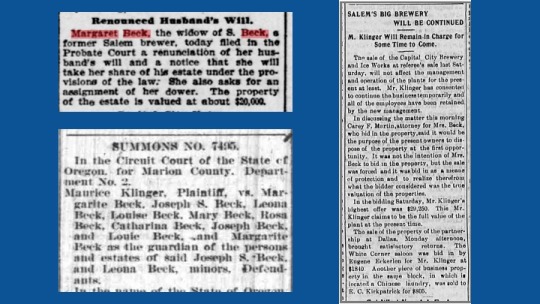
In April 1900, Margaret filed a “renunciation” of Seraphin’s will to get her share of his business estate, valued at $20,000. Four months later she asked the court to transfer guardianship of her children to her, which would allow her to sell the land left to them, and the following month, she was authorized to sell the property.
Two months later, Maurice Klinger sued Margaret in an effort to divide and sell the brewery property. On December 28, 1900, his court case began. In addition to describing the property locations, there are descriptions of the personal property held by the brewery. In addition to things in the saloon like chairs, tables, bar fixtures, beer glasses, and a clock, they also had things for making beer, like 700 bushels of malt, 3,000 bushels of barley, 7 bales of hops, 570 beer kegs, 25 fermenting vats, and 590 barrels of beer.
In late April, 1901, a notice of the business sale was posted in the newspaper and on May 5th the papers had this headline: “Brewery sold at auction. Salem's big beer factory is now owned by Mrs. Beck -- thirty thousand dollars was the price.” They reported “spirited bidding for the plant,” started at $17,500 from Maurice, followed by “a number of gentlemen who made bids until the $25,000 point was reached, when all dropped out except for Mr. Klinger bidding for himself, and Attorney Carey F. Martin, for Mrs. Beck, the latter securing the plant for $30,000.” In the following days, papers reported that Maurice would continue to manage the brewery temporarily and that all of the employees would be been retained, but also that Margaret planned to dispose of the property at the first opportunity. She said it was not her intention to bid on the property, but that the sale was forced and her bid was a means to show the true valuation of the properties. Maurice’s highest offer was $29,250, which is what he claimed to be the full value of the plant. In other words, he was willing to underbid the value, which meant less money for her in a legal split for the estate.
So, what was going on here? It seemed like there was an amount of time when they co-owned the brewery and it’s clear they had known each other for a long time. Why were they in court? It seems like he wanted to buy the brewery for less than it was worth and give her less? There was another clue in reports from Margaret’s 1904 petition to be discharged from the guardianship since her kids were of age. She said the sale of the Capital Brewery had been forced by Maurice’s partition suit. A real estate partition lawsuit occurred when two or more people owned a piece of property and had different ideas about what should be done with it.
Did he want to run it and she wanted to sell it?
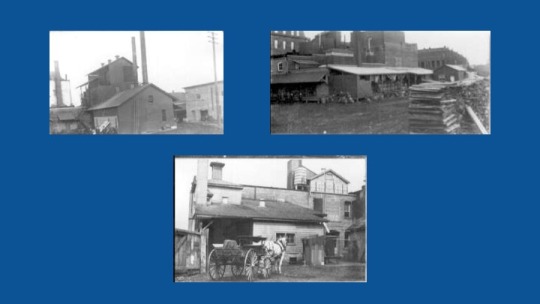
After the court cases were settled, Margaret got to managing. She advertised things, made improvements to the brewery, dealt with turnover in staffing, bought wood, and applied for a liquor license.
She was the sole proprietor of the Capital Brewery & Ice Works until June 5, 1903, when she sold it to Stanislaus Zynda, an agent for Leopold Schmidt of the Olympia Brewing Company, for $75,000. Though the July 1903 record of deed transfer show she was paid $34,000.
The Statesman Journal reported the sale June 5, 1903, noting that it was “one of the oldest established breweries in the state, and a very valuable property, which is increasing in value as the years go by, but the sale was a very satisfactory one indeed to Mrs. Beck, who was very anxious to retire from business. She has been conducting the business personally since the death of her husband, about two years ago.”
The owners of the new Salem Brewery Association planned to make extensive improvements in the plant, including tripling the output of the brewery and doubling the ice production, but also to make malting a more substantive part of the production. Though they planned to retain the same workers, there were some positions that needed to be filled or had been created with the new company: bookkeeper, brew master, and plant manager. I wonder who was doing this work before? And which of them Margaret did?

Thanks to find-a-grave and the Oregon State Library for these pictures.
In later years, some stories omitted the Becks from the story of the brewery – or at least diminished the equality that seemed to be inherent in the Beck and Klinger partnership. A 1919 article about the demolition of the 1857 brewery structure said the building “was remodeled into a brewery, the first in the Northwest, and was used for that purpose by Maurice Klinger.”
One from 1933, the year Prohibition was repealed, reported that the brewing industry would now be revived in Salem, and noted that Maurice Klinger was recalled as the first beer maker and built a plant in 1877. The source of this information? Maurice himself. “[S]omeone calls to mind the inscription on the tombstone of Maurice Klinger. Said epitaph in part being: He also built the first lager beer brewery in Salem August, 1, 1877 … Maurice Klinger also built the first ice plant in Salem, in June, 1888, according to the record of the tombstones.”
In 1946, author Ben Maxwell gave Maurice plenty of credit, writing that he “came to Salem in 1877 and purchased the present brewery site in 1885. He erected a plant 75 by 80 and before 1891 formed an association with Seraphin Beck. In that year their plant produced 3500 barrels of beer valued at $7,700.”
I do love this quote from a 2005 article: “A 6-foot red granite monument in the middle of the north section of the cemetery marks his resting place. The inscription proclaims in one and a half inch high letters that Klinger built the first ice plant in June 1888 and the first lager beer brewery in June 1877. The latter is debatable.”
There are other articles about Salem beer that provide similar and additional information, but also reflect attitudes of the time. In a 1969 article about Worth Mathewson’s large bottle collection, the author noted that “a walk down Mathewson's basement steps is a trip back to the days when ‘beer was beer and men were men.’” It’s written in a jaunty style, with plenty of references to the author’s own drinking and jokes about convincing the editor to approve the story. After finding a Blitz-Weinhard quart in 1960, Mathewson said he “wanted to learn everything I could about old bottles, the brewers and the men who made the beer.” No mention is given to Margaret; the author wrote “[t]hrough various deals and trades the Capital firm went into the hands of a family named Schmidt which formed the Salem Brewery Association.”
If we care about this history, we owe it to the people who made the beer and ran businesses to get it right.
Resources used for this post:
Google Books
Historic Oregon Newspapers
Ancestry.com
0 notes
Text
Mrs. Beck, a “lady of culture and refinement” with a “keen discrimination in matters of trade”
This is the second post from a talk I gave December 16 for the Willamette Heritage Center as part of their “Zooming Back to History” series.
Read the first post “What do we do with data?”
Read all my posts about Margaret Beck.

This post is the brief-ish story of the Capital Brewery, which Margaret Beck ran between 1901 and 1903.
Let’s start with more information about Margaret herself. There were several books written at the beginning of the 20th century about well-known citizens in the state, including the 1903 book Portrait and biographical record of the Willamette Valley, Oregon. Unsurprisingly, these books mainly include information about men and their accomplishments, but this book included a biography of Margaret and I want to read you a section: “The business interests of Salem find a worthy representative in Mrs. Marguerite Beck, who was for some time the owner of the Capital Brewery.” “After her husband’s death she assumed the management of his business affairs, and, in 1901, got out the interest of Mr. Klinger’s heirs and was the sole owner of the Capital Brewery until 1903, when she sold out. She remodeled the entire plant, and new machinery of the most modern kind and improvements was installed. In this connection she also operated an ice plant, engaged in the manufacture of pure ice, besides operating an extensive malt plant.” She was called “a lady of culture and refinement, who possesses marked business ability and keen discrimination in matters of trade.” So, she did a lot in a short amount of time.
Margaret was born in Wisconsin in 1860 to Anna and Paulus Neibirt, who were born and married in Germany. They immigrated to the United States soon after their marriage, and settled in New Holstein, Wisconsin, where Paulus was a farmer. She attended German schools in Wisconsin, and there is evidence that her father was successful at his work from a monetary standpoint.
The Neibirts moved to Oregon in 1871, first to Benton County and then the next year to Sublimity, where they purchased a farm. The Neibirts had seven children, four of whom were alive at the time Margaret’s biography was written in 1903. Her brother, Conrad, was murdered while defending his saloon in Canby during a robbery.
Margaret married Seraphin Beck January 20, 1880 in Marion County at Samuel Adolph’s house – Adolph was Seraphin’s boss in the brewing business. The 1880 census recorded the Becks living at 73 Commercial Street with two boarders: Virginia (born 1852 in what was then considered Germany) and Maurice Klinger (a brewer born 1844 in Germany).
The Becks had three kids: Joseph Seirphein, Mary Leona, and Louis Conrad, who died in 1891, when he was 10, of heart disease and spinal meningitis.
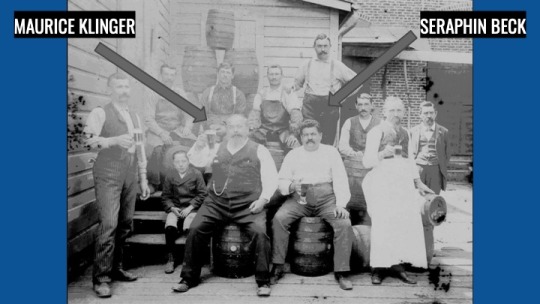
Thanks to the Oregon State Library for this photo!
Here’s a brief break to introduce Seraphin, who was born in 1851 in Alsace-Lorraine. He came to the United States when he was in his late teens or early twenties, and lived in Chicago for eighteen months, where he learned the brewing business. He lived in Denver for two years before moving to Salem. Exactly when he arrived is unclear, but around 1875.
There is an interesting kernel in Margaret’s biography in the Portrait and biographical record of the Willamette Valley I’ve yet to confirm and feel skeptical about: that Seraphin moved to Portland to be a head brewer for Henry Weinhard, a position he held until he became too ill to continue, when he returned to Salem. There was a Seraphin Klinger, Maurice didn’t have a son named Seraphin, who was listed in the city directories as a brewer at the Gambrinus Brewery in Portland from 1894 to 1901.
Weird.
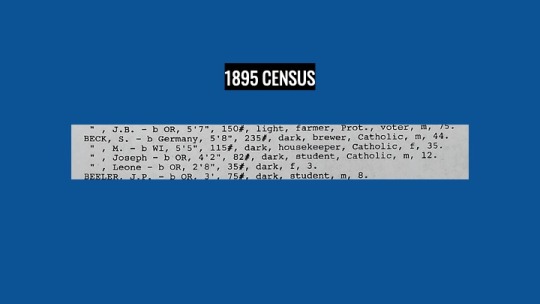
Most of the 1890 federal census was destroyed by fire, but certain counties or towns conducted their own mid-decade census. We are lucky this was the case with Salem because the 1895 census has interesting demographic information, namely a physical description of the family members. Margaret was a 35-year-old housekeeper, who was 5'5" and 115 pounds, she had dark hair and was a Catholic. Seraphin was 44 years old, a brewer born in Germany, 5'8" tall and 235 pounds with dark hair. 12-year-old son Joseph was 4'2" and 82 pounds with dark hair and a student. Daughter Leone was 3 years old, 2'8", 35 pounds, with dark hair.
Seraphin died on April 25, 1899 and was buried in the Catholic cemetery. Some contradictory information here too: one obituary called him a “full partner in the Salem brewing firm of Klinger & Beck,” while another said he was a "junior member of the Salem brewing firm of Klinger and Beck.” One obituary reported he’d been “more or less incapacitated for transaction of business for several years,” while another said he’d been ill with Bright's disease for six months. Contrary to the dates on their marriage record, both obituaries said he married Miss Maggie Neibirt in 1878.
Nonetheless, he was remembered as a successful business man with many friends, “of a quiet and unassuming disposition,” and a “man of exceptional integrity.” It was reported the saloons of the city would be closed the day of the funeral. He was buried near other brewers and purveyors of alcohol, including Mrs. Mary Eckerlen, wife of Virginia Klinger’s brother Eugene, who owned Eckerlen Saloon.

In 1906, 46-year-old Margaret married Joseph Thiel, a 55-year-old farmer who had immigrated from Germany in 1896. I may be reading into things, but this quote from the newspaper makes me feel like it was with some haste? “Although yesterday was a holiday County Clerk Allen was summoned to his office to accommodate a couple matrimonially inclined. The contracting parties, who will become man and wife today, are Mrs. Margarite Beck of this city and Mr. Joseph Thiel of Polk County.”
In the 1910 census, Margaret lived in Eola, with husband Joseph and son Joseph, a wage earner on a farm, and daughter Leona. That same year, Leona married Frank Domogalla. By the 1920 census, Leona was divorced, and once again living with Margaret and Joseph with her 5-year-old son Harold at 742 State Street. They all lived together in the 1930 census as well, in a rented house at 248 South Church Street.
Joseph died in 1933 and 4 years later Margaret died at aged 77 at her home at 1443 Saginaw Street. At the time of her death, her two children were still living, as well as her three grandchildren – grandson Harold and granddaughters Marguerite and Theo, who all lived in Salem. Her sister, Mary, also lived in Salem. Margaret’s estate was initially valued at $25,000; and in her will son Joseph was left a 200-acre farm, $100 went to each of her grandchildren, and the rest was left to Leona. Her final estate was valued at $43,000, nearly $800,000 in 2021 money.
Stay tuned for the next post, which narrows in on the years Margaret ran the brewery.
Resources used for this post:
Google Books
Historic Oregon Newspapers
Ancestry.com
0 notes
Text
What do we do with data?
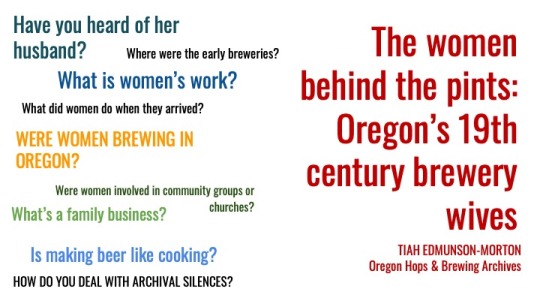
I gave a talk yesterday for the Willamette Heritage Center as part of their “Zooming Back to History” series. Much of what I talked about I’ve already shared on this blog, especially as it relates to my book.
Read all my posts about Margaret Beck.
But I also talked about data and the struggle I have about how we can feel good about making generalities about brewing in Oregon based on what we know.

I went to a talk by Randy Mosher at the 2021 Chicago Brewseum Beer Culture Summit and he talked about the ways we tell and receive stories; namely, that our brains crave detailed stories, but we like simple answers. We like to hear about the “firsts” or the “best” or the “exceptional.” But when we get “facts” or “data points” we have to set them into their context to understand them – and that means we need other data points.
As part of my book project, I read the 1850, 1860, 1870, and 1880 censuses. It took me 2 years. I was looking for people who identified as brewers in their occupation, but also looking for marital status, place of birth, and number of kids or lodgers.
I also used business registry books, newspapers, and northwest histories. It’s all very tedious and not very brief. I am very lucky because the census and historic newspapers are available online and I’ve spent a lot of time searching for keywords or names in the Historic Oregon Newspapers database run by the University of Oregon. In fact, it is newspaper advertisements that tell us much about the history of beer in Oregon.
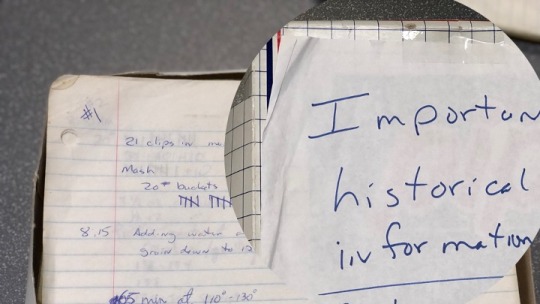
But here’s the problem with these “public” data points: they are not private thoughts. Add to that, many people didn't write down the things we are interested in. German beer books didn't include recipes and most 19th century Oregon breweries didn’t save records. Women who ran breweries didn’t record their feeling about property rights, children of brewers didn’t talk about going to school with children of Prohibitionists.
And the reality of beer history in the late 20th and early 21st century is that most beer history books have been written for trade publications. This is not to slight that work, at all, but as a rule they aren’t given the time to read the census or do the tedious research to tell an inherently messy and contradictory story.
There’s also the problem of articles or websites repeating what was written before rather than doing original research. Several articles were written about Salem beer since the repeal of Prohibition, and it’s clear that many are paraphrasing or rephrasing what their predecessors wrote rather than doing original research. But what is actually the most difficult for me, as someone who wants to trace the original story in original documents, is that most don’t cite their sources. Where an academic adds footnotes for everything, these other authors may just provide a works cited at the end or mention sources without giving information about how to find them.
The history of beer is a difficult story to tell. We’ve heard a standard narrative and we make assumptions that we should challenge.
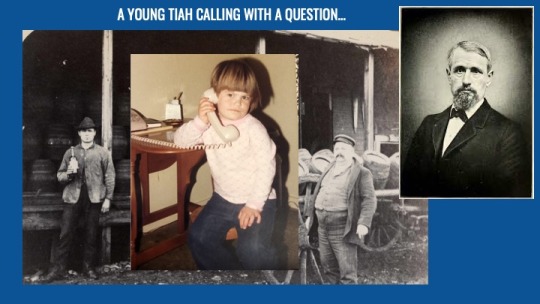
Let’s look at some data.

I’ve identified 539 brewers between 1850 and 1920 using the US census, newspapers, city directories, and books. You’ll note that the percentages of single and married brewers are pretty similar, but I do think most of the unidentified brewers were also probably single.
I’ve gathered a lot of data about brewers… And from what I found there’s a peak in the total number of brewers in the 1880s, which is not surprising because by then cities and towns had developed and breweries were employing more people, and as you coast in towards Prohibition, the numbers hold steady. By 1908, when local options abounded, there were a significant number of cities and counties with Prohibition, and many of the brewers from then are actually working in Portland – and for Henry Weinhard’s brewery.
I’ll also remind you that the 1890 census burned, so the majority of the data on brewers comes from directories, which don’t include wives’ names.
And this is a perfect transition! I’m not going to give much away with this statement: an important detail is missing from most history of 19th century Oregon beer: the brewers didn’t arrive alone and men weren’t the only ones running the businesses.

These are not women in Oregon. This picture shows women in a Burton upon Trent brewery in 1916 screwing down the yeast – basically activating it.
8 of those 539 people identified in records as running or working for a brewery were women: 1 was divorced, 7 were widows.
But these stats don’t lie: although there were a handful of women listed as business owners time, brewing in Oregon was a “man’s job.”
However, most of these breweries were based in or near the home and small in terms of production, so while the name over the door was a man’s, these were family businesses.

Of course, women have long done informal, unpaid, home-based work, more akin to bartering than industrial manufacturing.
Read more of my words about women’s work.
For women married to brewery owners, “keeping house” likely didn’t mean brewing; instead, their skills managing the household could easily transfer to managing the brewery.

For those of you who have been following my work, you know I love to talk about Louisa Weinhard, who was married to Henry. And you know she was almost certainly not stirring a kettle.
Louisa may have been the most visible brewer’s wife in Oregon, but she was not the only one.

Here’s Mary Allen from Monument, Marie Kienlen from Grants Pass, and Frederica Wetterer from Jacksonville, all women listed as brewery owners for a time.
Frederica was born in Germany and married to a brewer. Though the brewery was successful, her husband left her with significant debts that her father paid off. She was married again, to a miner who had little interest or skill in brewing. She ran the brewery and the distillery, but there’s not much evidence that she was regularly in charge of the actual production. Her obituary was in The Oregonian, with a picture, but her given name wasn’t included: instead, she was Mrs. Wetterer and Mrs. Healey. Here are a few pieces of trivia: her sister was married to one of the early Albany brewers and Frederica was listed as a male cooper in the 1860 census.
Read more about archaeology and Frederica.

The Capital Brewery made beer from 1885-1903, with Margaret Beck at the helm from 1901-1903.
It can be difficult to parse out “facts” from obituaries, newspaper articles, 19th century books, and even census records, and I haven’t found first-hand accounts from any of the people involved in 19th century Salem brewing. It’s also really difficult to find pictures, especially of women, so I don’t have any of Margaret. Thanks to the Oregon State Archives for putting this photo online –even if it doesn’t show her! And though there’s a lot to read into those census records and newspapers – this is an incomplete history, and always will be.
For now, I’m not going to tell the story of Louis Westacott, who opened his Salem brewery with a man named Miller in 1866. Nor will I go into any depth into the business operations or families of Samuel Adolph and Maurice Klinger, or Adolph’s early partner John Brown, aside from the fact that they are important characters in the business Margaret Beck eventually ran. I’m also won’t talk about the Salem Brewery Association, or the Loju juice they made during Prohibition, or about the post-Prohibition Sicks Brewery. Given the theme of this talk, I should acknowledge that I also won’t talk about their wives, but in the coming months plan to do deeper research on Mary Adolph, who was born in Germany sometime between 1842 and 1847; Virginia Klinger, born in present-day France in 1852; and Mary Westacott, born in New York in 1830.
Stay tuned for the next post, which is the brief-ish story of the Capital Brewery, which Margaret Beck ran between 1901 and 1903.
Resources used for this post:
Google Image Search
Google Books
Hathi Trust
Historic Oregon Newspapers
Ancestry.com
0 notes
Text
Maltona, Maltina, Malt Tea.
This is the sixth part of a series of posts on beer advertising.
Read the first: Salem beer history, advertising stock phrases, and a “pure beer” research plunge; second Beck v. Shultz: the battle for the lucky bear; third Purity, Progress, Patriotism; fourth Pure Food and Prohibition; and fifth “Why certainly! This beer is good for you.”
As promised, this is a post about beer ingredients (minus yeast and sometimes plus iron) all stirred together but not fermented. I like malt and I sort of liked hop soda, but I'm not sure what these "beer alternatives" would have been like? I'm imagining an Odwalla chocolate protein shake?
The North Pacific Brewing Co. in Astoria has a delightful assortment of characters in their Maltona brews!
We'll start with the mug, featured in the Heppner Gazette, July 16, 1908.

And a doctor in the La Grande Evening Observer, July 31, 1908, who looks like Freud to me...
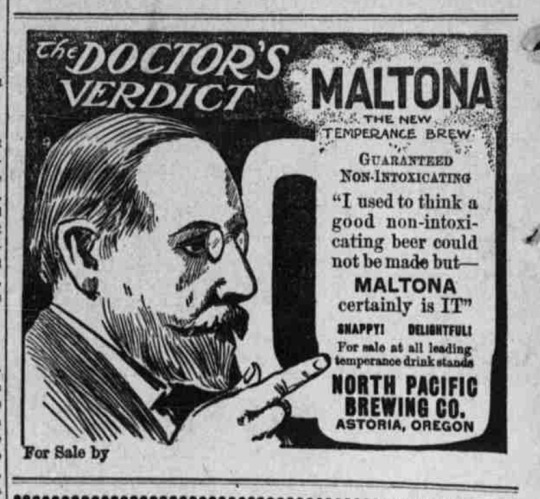
"The Doctor's Verdict is that Maltona, the New Temperance Brew, is guaranteed to be non-intoxicating, something this doctor did not think could happen!"

Everybody likes it. Even the children. (from The News Record, August 06, 1908)
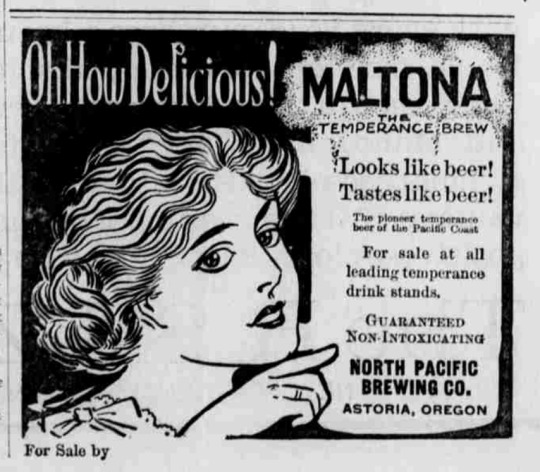
"Looks like beer! Tastes like beer!" But isn't beer. (from The News Record, August 13, 1908)
The La Grande Brewery made Maltina, which they marketed as a sort of "heritage drink," good for everyone and made with the finest ingredients – they are the ones that included iron.

"From one generation to another: Our new non-intoxicating beverage, Maltina, made from Hops, Iron and Malt, with the best water in Union county, will not only please the taste, but is also a splendid tonic. Good for young and old. No harm can result from its use and much good is inevitable. As a system builder it is unexcelled. As a beverage for pleasure only, it is unequaled. A trial order will convince you. All orders delivered at your home." La Grande Evening Observer., August 29, 1908, p6
It's also a drink for fancy people.

"Between ourselves there is nothing nicer, more refreshing or invigorating than a glass of our our and sparkling Maltina. It is a triumph of the brewer's art and instantly makes friends when first tried. It is a great thirst quencher and it is also good when not thirsty. As a tonic to the weak and convalesce it is freely recommended by physicians on account of its wholesome strength." La Grande Evening Observer., August 29, 1908, p6
And good for people in love?

"Hospitality from a pretty woman is always acceptable. Liquid refreshment in the form of our refreshing and exhilarating Bottle Maltina is particularly so. Put a stock of this in your cellar and you may be well assured of appreciative guests. And the beauty of our Maltina is that it is also healthful and nourishing as well as thirst-quenching and non-intoxicating. It is a body, bone and brain builder in liquid form." La Grande Evening Observer., October 15, 1908, p 8
And great for those trying to balance it all.

"The balance on a barrel is easily maintained and it is also easy to maintain one's balance on any quantity of Maltina, because it is pure, wholesome and guaranteed to satisfy thirst and not intoxicate. With some Maltina quality is a seesaw game - sometimes high, sometimes low, but with ours it is uniformly good and the price always right." La Grande Evening Observer., October 30, 1908, p 8
The Henry Weinhard brewery marketed juices during Prohibition, but before their plant had fully converted, it made malt tea.

“The Henry Weinhard brewery of Portland Oregon takes pleasure in announcing that its latest product malt tea and invigorating, strengthening and non-intoxicating malt beverage is now ready to be delivered in kegs or bottles for particulars address. Henry Weinhard brewery Portland Oregon." Daily Capital Journal, September 18, 1908, p 7.
Note that there are also ads for a phonograph and electricity, as well as the Little German Shoe Store on State Street in Salem.
Yes, now you can see how I really tipped over into the abyss...
So, much as I’d love to, I’m not going to write another post in this series looking at tinctures, cure-alls, tonics, or The Pure Food Movement as it relates to alcohol, because I really do need to prep my talk on Salem beer history!
Here are some teasers to encourage you to research on your own:
Hood's Cure ads. The largest proportion are in papers between 1880-1896. They do lots of things with this sarsaparilla! It cures constipation and purifies your blood. There are testimonies from around the country, from both men and women who have lung trouble, low energy, bilious attacks, near death experiences from an enlarged spleen, heart disease. Women wrote about husbands with ulcers on their legs that prevented them to work, son's with rheumatic fever, and their own general exhaustion from caring for others; Hood's gave her energy.
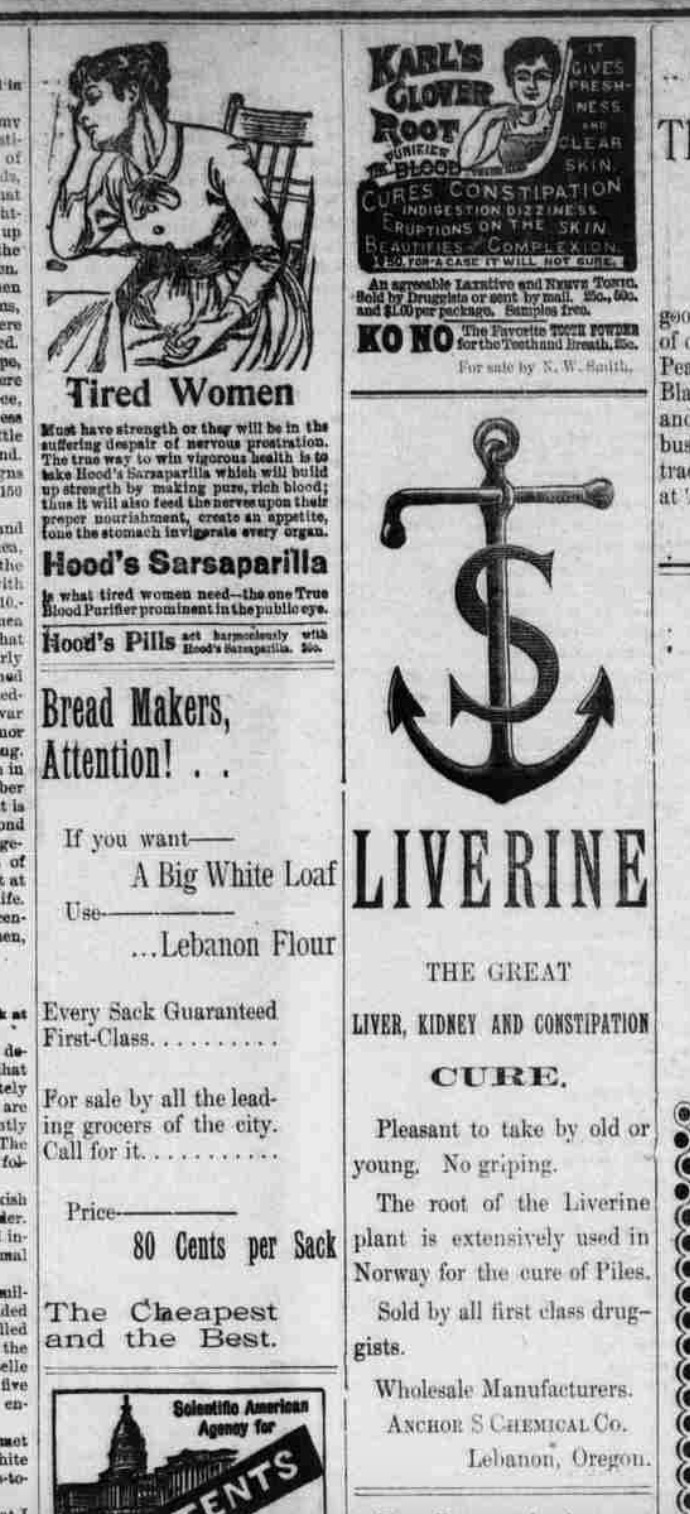
Hood’s Tired Woman...
There are also ads and articles for Peruna and Celery juice, and, of course, Hop Bitters!
I'm a fan of this article about an intoxicating non-intoxicant and this one about all the things hop bitters can help you with.
#beer history#oregon beer#temperance#prohibition#women in brewing#women in advertising#women pure food ads
0 notes